Archive for the ‘Threats from Mining’ Category
Thursday, May 16th, 2013
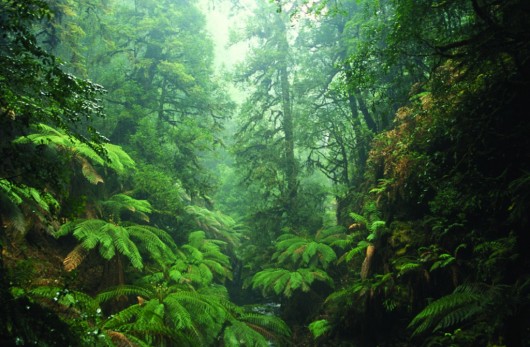 Arthur River Rainforest in Tasmania’s Tarkine
[Source: Photo by Ted Mead, ^http://tarkine.org/) Arthur River Rainforest in Tasmania’s Tarkine
[Source: Photo by Ted Mead, ^http://tarkine.org/)
.
.
Mar 2013: Savage River tailings spill exactly why we shouldn’t have new mines in the Tarkine
.
<The EPA announcement that an acid forming tailings spill has occurred at the Savage River Mine is evidence of the risks posed to the Tarkine by proposed new mines.
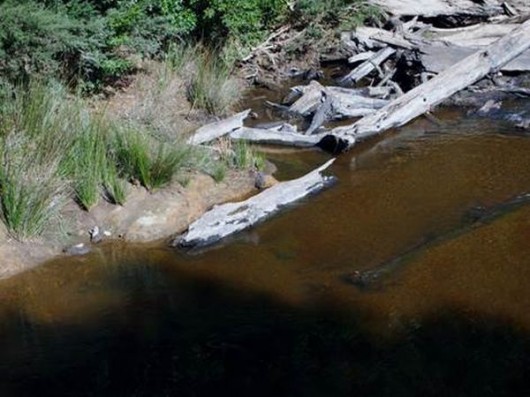 Savage River Mine tailings spill into Tasmania’s wild Pieman River
[Source: ‘‘I have never seen anything like it’, 20130325, by Isla MacGregor, Tasmanian Public and Environmental Health Network,
in Tasmanian Times, ^http://tasmaniantimes.com/index.php?/weblog/article/i-have-never-seen-anything-like-it/] Savage River Mine tailings spill into Tasmania’s wild Pieman River
[Source: ‘‘I have never seen anything like it’, 20130325, by Isla MacGregor, Tasmanian Public and Environmental Health Network,
in Tasmanian Times, ^http://tasmaniantimes.com/index.php?/weblog/article/i-have-never-seen-anything-like-it/]
.
Tarkine National Coalition Campaign Coordinator, Mr Scott Jordan:
“The mining industry has been telling us that modern mines are safe and environmentally sound, and yet here we have evidence that even with the best of intentions from an award winning operator, there is always unacceptable risks. Accidents can and will happen, and the environment will suffer the costs”.
TNC are urging a EPA to make their investigation transparent and to make the findings public. >>
.
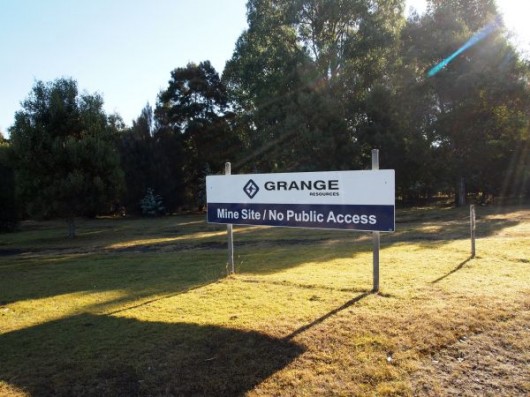 Grange Resources, Savage River Mine
Recklessly destroying and polluting The Tarkine
thanks to disinterested approval by selfish old men Babyboomer politicians in Hobart Grange Resources, Savage River Mine
Recklessly destroying and polluting The Tarkine
thanks to disinterested approval by selfish old men Babyboomer politicians in Hobart
.
Mar 2013: Statement of Reasons sought on Tarkine Heritage decision
.
<<Community advocate to save The Tarkine, the Tarkine National Coalition, has written to Federal Environment Minister Tony Burke and formally sought statement of reasons relating to the Tarkine National Heritage decision. The request is pursuant to Section 13 of the Administrative Decisions (Judicial Review) Act 1977.
Under the Act, upon request the Minister must provide a statement of reasons within 28 days of the request being made.
The TNC is still awaiting a statement of reasons relating to the Nelson Bay River mine approval, and last week instructed solicitors to write again to the Minister to alert him to his legal obligations.
Mr Scott Jordan:
“We have a view that the decision to not heritage list the Tarkine was not based on the evidence before the Minister. There are no documents that have been released supporting the case to not list the area, and so we are very keen to see the Minister’s reasons for this decision”.
The Australian Heritage Council recommended a 439,000 hectare National Heritage Listing.>>
.
 . .
Mar 2013: CNN names Tarkine first in CNN’s world’s last great wilderness areas
.
<<The Tarkine has been named first in CNN’s list of the world’s last great wilderness areas. Tarkine National Coalition has welcomed this international recognition of the Tarkine’s wilderness values.
Mr Scott Jordan:
“CNN has confirmed what we have known all along. The Tarkine is a remarkable and unique place that deserves to be listed as one of the worlds great wilderness assets. The challenge now is for our state and federal governments to ensure that the Tarkine is protected through National and World Heritage listing”.
Over the past decade the Tarkine has delivered on the jobs front, with visitor numbers and Tarkine related jobs growing even in the current national downturn.
“The Tarkine continues to grow it’s reputation as a premier tourist destination. The new mines proposed will kill the golden goose”.>>
.
Feb 2013: Watering down of mine permit conditions unacceptable
.
<<The Tarkine National Coalition has received written notice that Circular Head Council has “deleted” a permit condition aimed at providing protecting watercourses on the Nelson Bay River proposed mine site.
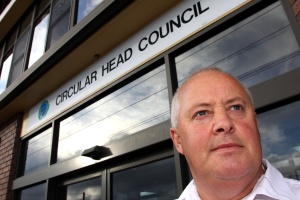 Circular Head Mayor Daryl Quilliam
(a Babyboomer…) Circular Head Mayor Daryl Quilliam
(a Babyboomer…)
.
The deleted condition stated ‘Apart from the creation of the site’s access, no building works or vegetation clearing shall occur within 30 metres of a watercourse’.
Mr Scott Jordan:
“Here we have a council who is hell bent on doing whatever it takes to get a mine up in the Arthur Pieman Conservation Area, and the environment be damned. The Nelson Bay River and it’s catchment creeks provide drinking water to local wildlife, including threatened species like the Tasmanian devil and Spotted tailed quoll. It also discharges just 5 km downstream into the shack community of Nelson Bay, a popular fishing and crayfishing location”.
“It appears the rules don’t apply if you are a mining company. Before they’ve even commenced operations Shree Minerals is calling the shots and dictating the rules”.
The Nelson bay River proposed mine sits within the area the Australian Heritage Council recommended as a 439,000 hectare Tarkine National Heritage Listing.>>
.
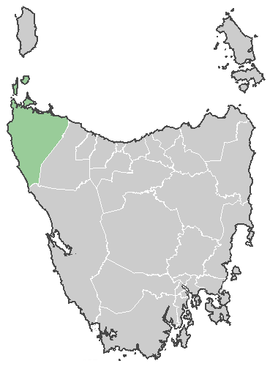
.
Feb 2013: Minister fails to comply with legal requests
.
<<Federal Environment Minister Tony Burke has failed to comply with a legal request for a Statement of reasons pursuant to Section 13 of the Administrative Decisions (Judicial Review) Act 1977. Tarkine National Coalition had formally sought statement of reasons relating to the EPBC approvals for the Nelson Bay River mine. ‘
Under the Act, upon request the Minister must provide a statement of reasons within 28 days of the request being made. This period expired on 18th February.
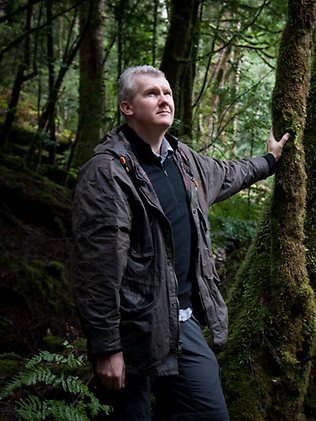 Federal Environment Minister Tony Burke Federal Environment Minister Tony Burke
.
The TNC has instructed solicitors to write again to the Minister to alert him to his legal obligation and again request the statement of reasons.
Mr Scott Jordan:
“There are serious concerns with the Minister’s complete disregard for the legal obligations of his portfolio. This combined with his inability to tell the truth leaves us with absolutely no confidence in this Minister”.
“The Minister made comment last night on ABC’s Lateline that the current Tasmanian Forest Agreement process would protect the Tarkine. The reserves proposed in this agreement would allow for new mining and exploration activity, a fact the Minister is aware of. He has kowtowed to the mining bosses and now wants to paint himself in a better light. Unfortunately the fact speak contrary to the Minister’s statements.”
Mr Jordan congratulated and thanked Australian Greens Senator Christine Milne for raising the plight of the Tarkine in her National Press Club address yesterday.
“Senator Milne has hit the nail on the head. Tony Burke is working against the public interest and for the mining bosses”.>>
.
 Mr Scott Jordan
Tarkine National Coalition
(Photo by Eliza Wood). Mr Scott Jordan
Tarkine National Coalition
(Photo by Eliza Wood).
.
[Source: Campaign Coordinator Scott Jordan, Tarkine National Coalition, PO Box 218, Burnie, Tasmania, 7320, ^http://tarkine.org/]
.
Friday, April 26th, 2013
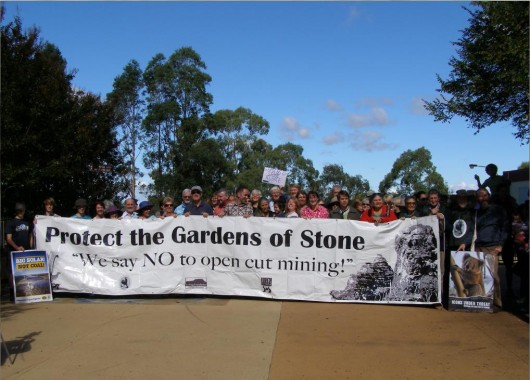 Rally in Springwood last Sunday to save the Gardens of Stone from mining Rally in Springwood last Sunday to save the Gardens of Stone from mining
[Photo by Editor, 201340421, Photo © ^Creative Commons]
.
Coalpac ‘Consolidation’ Project
.
 . .
Two years ago in July 2011, corporate coal mining company, Coalpac Pty Ltd, lodged a development proposal with the New South Wales Government to expand its open-cut and high wall coal mines. The sites are within the proposed extension of the Gardens of Stone National Park and surround the small rural village of Cullen Bullen in central-western NSW, both situated along the Castlereagh Highway about 25 km north-west of Lithgow.
Coalpac’s Consolidation Project involves expansion of mining operations at (1) the Cullen Valley and (2) Invincible coal mine, and establishment of a new quarry and associated infrastructure. Basically, Coalpac wants to consolidate (mining spin for ‘expand’) its Invincible and Cullen Valley coal mines and construct a new quarry in the Ben Bullen State Forest near Lithgow.
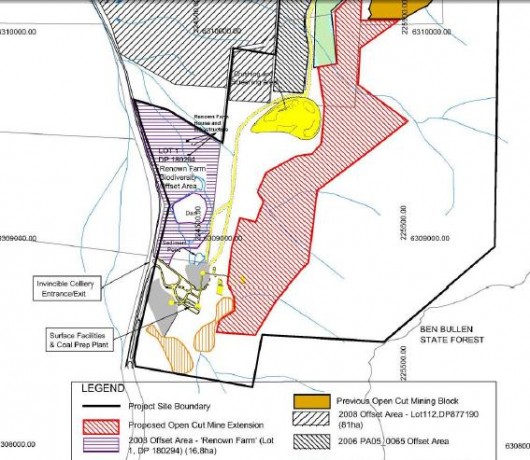 Coalpac’s colliery extension Coalpac’s colliery extension
.
Coalpac acquired the assets of the Lithgow Coal Company in February 2008. Coalpac was originally owned by the Liberman family and remains privately owned. Coalpac has a 20-year contract to provide thermal black coal to nearby Mount Piper Power Station owned by Delta Electricity.
The scale of the expansion will see production of up to 3.5 million tonnes of coal from the two mining operations and up to 640,000 tonnes of extractive material a year from the quarry operation. The intended life of the coal mining is to be 21 years.
The relevant authority, the NSW Department of Planning and Infrastructure’s, Deputy Director-General Richard Pearson said the company’s first environmental assessment did not adequately address the project’s potential impacts on biodiversity, natural, historic and Aboriginal cultural heritage, noise, air quality and groundwater.
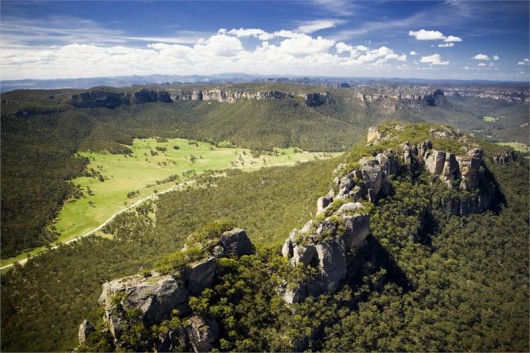 The magnificent Gardens of Stone under threat of mining The magnificent Gardens of Stone under threat of mining
(Hamilton Lund, Tourism NSW)
.
In January 2012, Coalpac re-submitted its development proposal and “after liaising with the department on a number of issues, the proponent submitted a revised EA in mid January which has now been deemed adequate,” according to Mr Pearson.
However, many localand regional people continue oppose the expansion, no less the immediate residents of Cullen Bullen. The public exhibition period for both mine sites was for eight weeks between 1oth April and 1st June 2012.
The proposal includes:
- Consolidating development consents and project approvals at both the Invincible and Cullen Valley coal mines so that one approval regulates mining across both sites;
- Expanding open cut and high wall mining areas, to extract an additional 108 million tonnes of coal;
- Upgrading and building associated infrastructure to process 3.5 million tonnes of coal per annum and transport coal off the site by road and rail;
- Producing up to 640,000 tonnes of sand products each year;
- Clearing approximately 960 hectares of vegetation, primarily within Ben Bullen State Forest; and
- Rehabilitating the site.
.
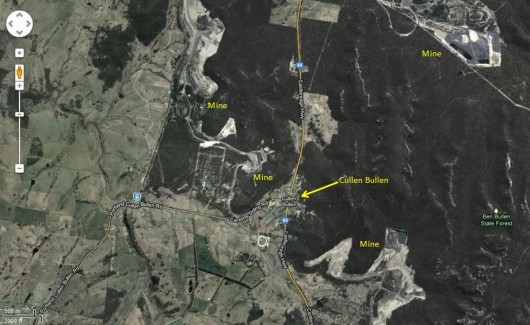 Cullen Bullen satellite map
[Google Maps 2013, click image to enlarge] Cullen Bullen satellite map
[Google Maps 2013, click image to enlarge]
.
A threatened species confirmed to be existing in the Ben Bullen State Forest area adds to a growing list of flora species Coalpac Pty Ltd has failed to identify within its flora assessments for current and proposed mining projects. Environment group’s caution the company’s track record raises further concerns for the community over the ‘Coalpac Consolidation Project’ Cullen Bullen NSW.
The Office of Environment and Heritage (OEH) recently confirmed the existence of the threatened species Persoonia marginata within Coalpac Pty Ltd’s Cullen Valley Mine mining lease.
To cirumvent ecological provisions of the national Environment Protection and Biodiversity Conservation Act 1999 (the EPBC Act), sections 18 and 18A (Listed threatened species and communities) and sections 20 and 20A (Listed migratory species), the proposal includes a biodiversity offset strategy, which would potentially allocate more than 1,755 hectares of land as biodiversity offsets.
“Despite undertaking seven field surveys before lodging this Proposed Action at least 75 plants were missed in their surveys. There are in fact at least 350 plant species of which 6 are listed as Rare or Threatened Australian Plants (ROTAP) existing within the proposed area to be cleared. In effect, the ecological surveys have understated the diversity of the area to be open cut,” says Chris Jonkers, Natural Areas Project Office of the Lithgow Environment Group.
“Due to Coalpac’s track record of inadequate flora assessments, environment groups are calling for the Department of Planning to commission an independent flora assessment. The results of this combined with other threats to matters of national environmental significance, we would see the proposal be rejected by the NSW Government,” says Mr Jonkers.
“The natural and recreational values of the area have a life span well beyond the 21 years Coalpac would take to destroy the heritage value of this gateway area to the Gardens of Stone,” says Mr Jonkers.
.
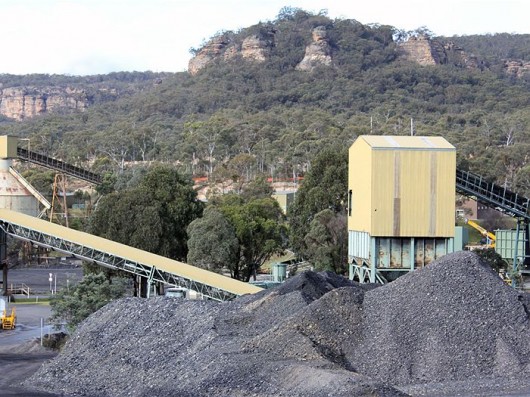 Coalpac’s Invincible Colliery undermining below pagodas of the Gardens of Stone Coalpac’s Invincible Colliery undermining below pagodas of the Gardens of Stone
[Photo: Leone Knight, ^http://www.abc.net.au/rural/regions/content/201204/3490112.htm]
.
Coalpac’s open cut coal mining expansion is set to be within 500 metres of Cullen Bullen residents and threatened to operate 24/7, causing unrelenting industrial noise and to inflict toxic coal dust upon Cullen Bullen and over 21 years, so effectively killing Cullen Bullen.
Nearly all residents of nearby Cullen Bullen have protested against the mine’s expansion, except a few who are selfish employees of Coalpac.
In April 2012, residents of Cullen Bullen presented the Member for Bathurst with a petition opposing a proposed open-cut coal mine near the town. Over two thirds of the Cullen Bullen residents signed the petition against the open-cut development; however they do say they would support the proposal if the mine was underground.
Paul Toole the National’s member for Bathurst says they have legitimate concerns, and he would be taking them to the NSW Minister for Planning Brad Hazzard. Squat difference that made.>>
[Source: ‘The Battle for Cullen Bullen’, 20120427, ABC Rural, ^http://www.abc.net.au/rural/regions/content/201204/3490112.htm]
.
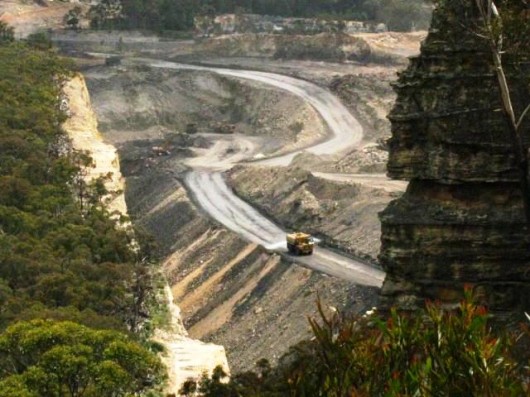 Invincible Mine Invincible Mine
.
Divide and Conquer the local residents…
.
According to Blue Mountains Conservation Society campaigner Justin McKee, Coalpac seems to be employing an ‘age old’ Caesarian mining strategy of ‘divide and conquer‘ in order to get its way in forging ahead with its devastating open cut mining project.
“The process any mining company will follow to divide and then conquer a community is age old and I’ve witnessed this in the Hunter Region time and time again,” Mr McKee said.
“First a company will employ the nicest person they can possibly find to be the community relations officer to forge local relationships. “The company will then go about understanding exactly what the local issues are, create local community opinion leaders while buying up land and offer the loudest people in the community either jobs or above market rate sums for their property and demand they sign confidentiality agreements.
“All the while the company will claim the middle ground in all its communications so that others’ opinions seem radical.
“Finally, the company will set about marginalising everybody else so that the community is left completely divided.”
[Source: ‘Protect the Gardens of Stone’, media release, Blue Mountains Conservation Society, 20110531]
.
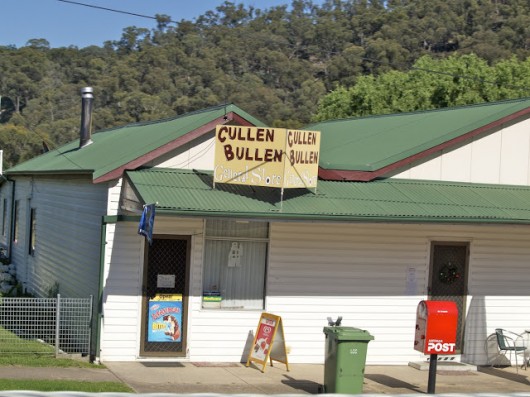 Cullen Bullen General Store
[Photo: ^http://sweetwayfaring.blogspot.com.au/2011_01_01_archive.html] Cullen Bullen General Store
[Photo: ^http://sweetwayfaring.blogspot.com.au/2011_01_01_archive.html]
.
Plea by Cullen Bullen resident, Eva Rizana
Public Speech delivered at Springwood on Sunday, 21st April 2013
Eva is a long standing resident of Cullen Bullen.
<<Good Morning Everyone. Firstly I’d like to say that I’m grateful for the opportunity to speak here today. I’m not a public speaker but will do my best.
I’m here today to give a local perspective on the Coalpac Consolidation Project and its impact on the people of Cullen Bullen. My name is Eva Rizana and I spent the first 25 years of my life as a resident of Cullen Bullen and have both lived there and visited on numerous occasions since.
My grandparents had businesses in the township. A bakery in the 1960’s and the Post Office during the ‘70’s, ‘80’s and 90’s. I myself worked at the post office, a local berry farm and at the school. My family still owns a half acre block and family home in Cullen Bullen. For those of you who don’t know Cullen Bullen is a town about 20 minutes out of Lithgow as you head towards Mudgee.
While most of what I will share with you today is my own personal story, there are many residents of Cullen Bullen who have similar stories to tell.
I first came to know about the Coalpac Consolidation Project when we received one of their newsletters in our mailbox. The newsletter outlined the Coalpac Consolidation Project. There was a map along with some technical information about the operation of the mine. To be honest I didn’t really understand all the technical information, but the map made it very clear that the proposed mine would be very, very close to the town. Essentially the Coalpac Consolidation Project would mean that the 200 residents of Cullen Bullen will be living in the middle of an open cut mine for the next 20 years. Like most of the residents of Cullen Bullen at that time, my family felt lost, confused and extremely isolated.
The proposal is for the mine to operate 24 hours a day 7 days a week, with blasting occurring several times a week. In some cases the mine operations will be only 500 meters from homes, and obviously the people living in those homes.
The NSW Department of Health, along with local doctors have raised concerns about the impact of mining operations on the health of the residents. While I’m extremely grateful for their contributions and welcome the knowledge and expertise that they bring to the argument, I find it slightly disturbing that we have a system that requires professional evidence that living in the middle of a 24 hour, 7 day a week open cut mining operation for 20 years, is detrimental to people’s health. To me and to the majority of residents of Cullen Bullen its simply logical that being within 500 meters of the dust, fuel fumes, noise and in close proximity to the blasting generated by the mine isn’t good for the health of residents.
I know of numerous residents whose health has already been impacted by the existing mine operations, just over the hill in Tyldesley . Their symptoms include itchy eyes, itchy skin, skin rashes and hives as well as breathing difficulties. These symptoms clear up or go away when they leave the area for extended periods of time such as going away on holidays, however quickly return once they come back home to Cullen Bullen. I’m also disturbed that the very real experiences of these people can’t be offered as further evidence on the detrimental effects of open cut mining in close proximity to people.
In addition to these health concerns many residents have concerns that relate to damage to the structure of their homes as well as the financial impact the mine will have on the value of their homes.
I understand that Coalpac has agreed to compensate residents for any damages caused to their homes by the mining operations. Sounds reasonable doesn’t it ?….Until you find that your home has been damaged and that Coalpac can present a multitude of reasons other than its mining operations to explain the damage. So not only do these people have damage to their homes, they are also out of pocket and angry at the empty promises made and assurances given.
Quite frankly, the majority of residents of Cullen Bullen don’t trust Coalpac to fulfil in full the terms of their proposal and we also feel let down by some authorities in not forcing them to comply with some of the terms already agreed to.
To offer an example:
As mentioned, Coalpac has an existing mine just outside of Cullen Bullen. They started mining operations there about 12 years ago. Their original mine was open-cut but was supposed to convert to underground mining after a certain period of time (approximately 4 years I believe). Well here we are 12 years later and the mine is still operating as an open cut mine. My understanding is that the mine couldn’t go underground due to fire in many pockets of coal. This sounds reasonable and I’m certainly not promoting the use of mining practices that would endanger the safety of the miners or other workers – but can you see how from our perspective Coalpac has developed for themselves a reputation of not fulfilling promises. Most residents believe that if the proposal were to be approved Coalpac would start pushing the envelope in terms of things like blasting times, noise and dust restrictions, and proximity to homes and pagodas.
Speaking of Pagodas, I believe some of you went to visit the unique “Gardens of Stone” recently. These structures along with other beautiful landscapes make the area around Cullen Bullen a great place for tourists to visit. Australia’s own Grand Canyon is just up the road near the town of Capertee while Cullen Bullen itself is surrounded by many unique rocky outcrops and pagodas, all of which are now under threat.
According to a recent article published in the Lithgow Mercury (10th March 2013) written by Noel Craven, a man who I understand has extensive experience in the mining industry – based on current mining techniques and reserves, Lithgow’s mining industry has a lifespan of around 40 years. That’s only one generation of workers. I want to repeat that because I believe it’s a significant point. Lithgow’s coal industry is not sustainable beyond 40 years.
So much mainstream media has been focused on the local jobs that the Coalpac Consolidation Project could provide. However all of the energy being given to this argument takes the focus away from the fact that according to Noel Craven’s statistics taken from Lithgow Council Economic Development Strategy, Coal Industry Profile, almost 30% of Lithgow District’s workers will be faced with unemployment in 40 years.
I find that figure completely staggering. How can mainstream media be so focused on the comparatively small number of local jobs currently under threat by mine closures when the entire industry itself will be gone in 40 years?
Now here’s the thing – If the Coalpac Consolidation Project is approved, the very thing which may have saved Lithgow and District from mass unemployment, in the form of tourism to places such as the Gardens of Stone, will be gone.
It seems to me that the voices that are being heard in mainstream media are not painting a complete picture. Yes, mining does create local jobs and that is important, but to the best of my knowledge only 3-4 residents of Cullen Bullen are employed by Coalpac. That’s 3 -4 people out of a population of around 200 people.
Coalpac’s Consolidation Project proposal states that around 1 -2 % of its workers will be sourced locally. In my opinion, the media, including Sydney based Shock Jocks have either been manipulated or have themselves manipulated the facts surrounding this situation and many people now believe misinformation. It seems to me that the voices of people such as me are being drowned out. Again another reason I’m grateful to have been given this opportunity to speak and hope that I am doing justice to the many who have been standing their ground in and around Cullen Bullen for 12 and in one case 17 years.
I’d love to say that the current situation around the Coalpac Consolidation Project has brought the town together. Unfortunately, from my perspective the Cullen Bullen that I grew up in has already disappeared. The sense that, even though things weren’t perfect, we all pulled together when we needed to has gone. Big business and big money, along with loads of misinformation have divided the town. The fact is that the majority of residents do object to the proposal as evident by the more than 4:1 ratio of submissions from Cullen Bullen residents to the Department of Planning objecting to the proposal. The few ( 3-4) Coalpac employees along with their families understandably support the mine. To me, it feels like the people of Cullen Bullen are being used as pawns in a game that we have no chance of winning. Coalpac knows how to play this game and are using their knowledge and resources to win.
The social dynamics of Cullen Bullen have been changed beyond recognition.
In closing, I appreciate the spotlight that the “Icons Under Threat” Tour has put on the Coalpac Consolidation Project and the negative impact it will have on the health and financial well-being of the residents of Cullen Bullen. We don’t want to become another Maitland, Singleton or Ulan moonscape.
While you might hear a different story in mainstream media – the truth is the vast majority of Cullen Bullen residents are opposed to the mine, and anything that can be done to avoid future generations having to fight this same battle over and over again would be most welcome.
Thank you.>>
[Source: Eva Rizana, (resident of Cullen Bullen), public speech, 20130421]
.
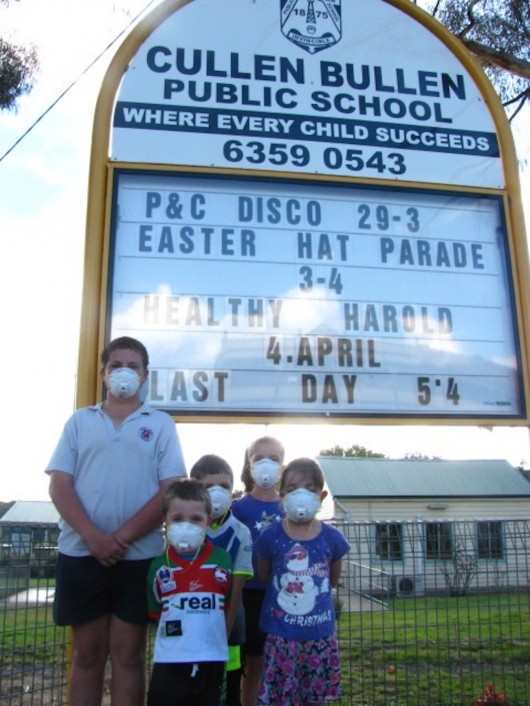 . .
Community rally opposing coal mining
.
<<The fight to save the Gardens of Stone near Lithgow came to the streets of Springwood on Sunday when residents rallied in the town square calling on the government to protect the area from coal mining.
Organised by the Blue Mountains Conservation Society, Lithgow Environment Group and Nature Conservation Council of NSW (NCC), the rally was the final event in a week-long tour by senior NCC staff of areas across the state facing coal mining and gas developments.
The Gardens of Stone has escarpments, canyons, upland swamps, rock arches and pagodas that provide habitat for many endangered plants and wildlife.
.
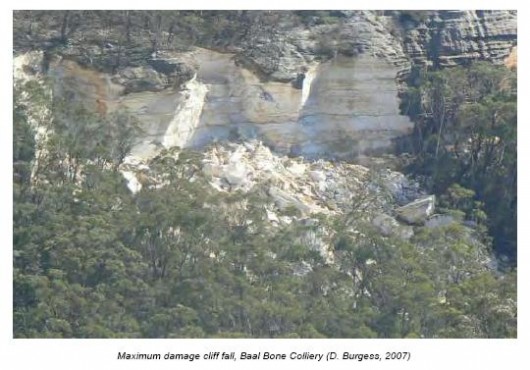
NCC chief executive officer Pepe Clarke said even though the Planning Assessment Commission made damning findings against the proposal in December, the area was still vulnerable.
“Coalpac’s revised open-cut coal mine proposal at Cullen Bullen north of Lithgow is still a very real threat to this iconic area and must be opposed at every opportunity,” Mr Clarke said.
“The O’Farrell Government now has an historic opportunity to protect this unique part of the state’s environmental heritage for future generations and to improve its poor environmental credentials by declaring it a State Conservation Area. People should not have to fight this fight — this should be protected up front.”
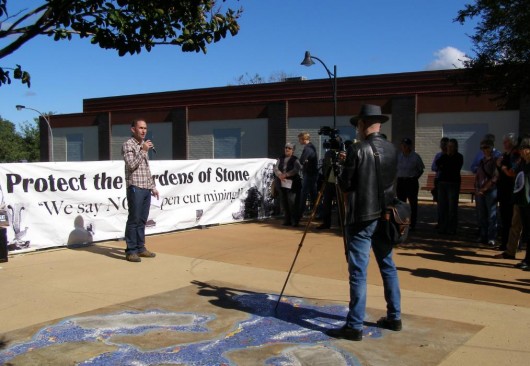 Pepe Clarke of NCC speaking at the Springwood Rally, 20130421 Pepe Clarke of NCC speaking at the Springwood Rally, 20130421
.
Tara Cameron, vice president of the Blue Mountains Conservation Society, said approval of the proposal would open the door to the “visual cancer of strip mining along the steep forested edges of the Greater Blue Mountains”.
“These long thin strips of steep and elevated lands are very difficult to rehabilitate and will become, for all time, areas of visual blight, destroying the region’s greatest tourist asset, its stunning scenery. It must be stopped,” she said.
“To allow open-cut mine anywhere is bad, but to ruin the Gardens of Stone would be intolerable. The government has a clear responsibility to reject the Coalpac proposal and protect the area forever by declaring it a State Conservation Area.”
Blue Mountains MP Roza Sage responded that “although the Gardens of Stone are not in the Blue Mountains I fully understand the concerns of the conservation society. The Coalpac expansion proposal was referred to the Planning Assessment Commission (PAC) and the commission’s independent review report was publicly released on December 20, 2012. The PAC recommended that the coal mine expansion project not proceed, partly on environmental grounds.
“A final decision on the proposal is still to be made by the government. No decision on Gardens of Stone [stage] 2 [proposal] National Park can be made before that time,” she said.>>
[Source: “Springwood protest over Gardens of Stone mine proposal, 20130424, ^http://www.bluemountainsgazette.com.au/story/1454027/springwood-protest-over-gardens-of-stone-mine-proposal/?cs=2062]
.
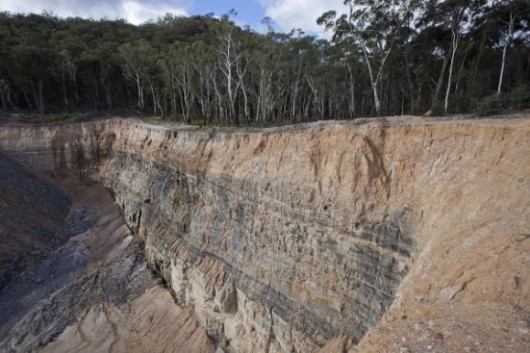 Gardens of Stone being mined to oblivion
(Photo: Blue Mountains Conservation Society) Gardens of Stone being mined to oblivion
(Photo: Blue Mountains Conservation Society)
.
.
Sunday, April 21st, 2013
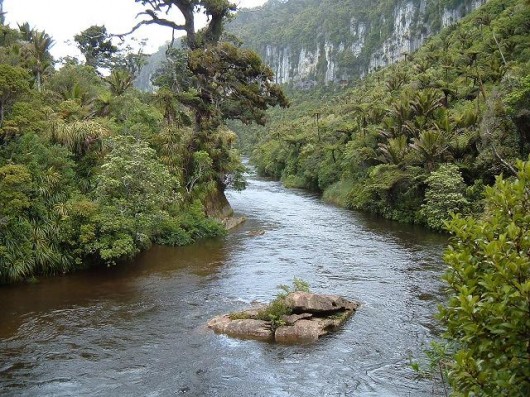 Wild Poporari River protected inside Paparoa National Park
Similar to nearby but unprotected cousin Pike River
Both inside Te Wai Pounamu (New Zealand’s South Island)
Note the Nikau Palms (Rhopalostylis sapida) endemic to New Zealand. Wild Poporari River protected inside Paparoa National Park
Similar to nearby but unprotected cousin Pike River
Both inside Te Wai Pounamu (New Zealand’s South Island)
Note the Nikau Palms (Rhopalostylis sapida) endemic to New Zealand.
.
Poporari River is a wild river of New Zealand’s South Island that flows from headwaters and chasms below the rugged mountainous Paparoa Range, westward into the Tasman Sea. Since 1987 the river and some of the range have been rightly protected within the Paparoa National Park.
But the Pike River flows from the other (eastern) side of the Paparoa Range, just outside the national park. It is a tributary to Big River which in turn flows south of the Paparoa Range into the Mawheranui (Grey River) and eventually westward through the town of Greymouth and out to the Tasman Sea. Yet of the Poporari River and the Pike River, their forest and riverine ecosystems are the same.
‘Paparoa‘ is Māori for ‘long place‘. The Paparoa Range extends parallel to the west coast for about 50 km south-south-west from the lower Buller Gorge, between the Grey and Inanga-hua Valleys and Tasman Sea and the coastal plains. The range aproximates heights of over 4,000 ft with the heighest peak being Mount Uriah at 4,925 ft.
The Paparoa Range bedrock is of granite formed during Earth’s pre-Cambrian Era (over 600 million years ago), and the range subsequently uplifted during the early Pleistocene Epoch (2.6 million years ago), was then carved by glacial action during the Ice Age 20,000 years ago, and since eroded by water and wind leaving sharp ridges, steep cliffs, cirques, and deeply incised rivers and streams.
[Source: Frederick Ernest Bowen, B.Sc.(Durham), New Zealand Geological Survey, Otahuhu, New Zealand, in Te Aara – The Encylopaedia of New Zealand, 1966, ^http://www.teara.govt.nz/en/1966/paparoa-range]
.
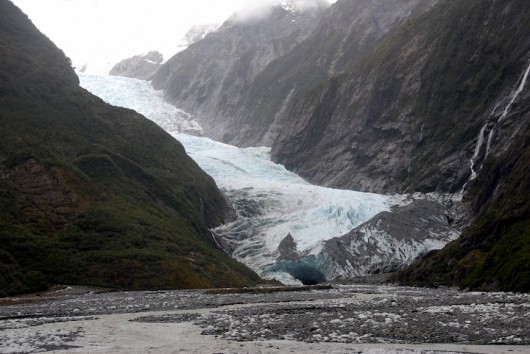 Glacial action still evident further south in Tai Poutini National Park
[Source: ^http://www.duwal.com/en/travelguide/australia/new-zealand/westland-tai-poutini-national-park] Glacial action still evident further south in Tai Poutini National Park
[Source: ^http://www.duwal.com/en/travelguide/australia/new-zealand/westland-tai-poutini-national-park]
.
Limestone underlies most of the Paparoa National Park and it is responsible for the area’s amazing landforms – high coastal cliffs, impressive river canyons, delicate cave formations and the bizarre ‘pancake-stack’ coastal formations that the area is so well known for. The national park is perhaps most famous for the ‘pancake rocks’ and blowholes of Dolomite Point, near the little settlement of Punakaiki.
The Park is also famous for Cave Creek which flows through a 30-metre chasm emerging from a limestone karts system deep beneath the Paparoa Range.
.
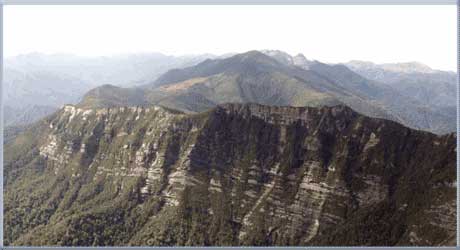 The Paparoa Range
above the Pike River The Paparoa Range
above the Pike River
.
Paparoa National Park is characterised by luxuriant coastal forest, limestone cliffs and canyons, karst systems and underground streams, and an absolutely spectacular coastline.
Vegetation within the park is wide and varied, due to the mild climate and high fertility. With an annual rainfall of 350–500 mm, the Paparoa Range below 3,500 ft is dominated in thick Podocarp Hardwood Forest (broadleafed) canopy. Above 3,500 ft, a thin narrow belt of subalpine scrub giving way to mountain grasses on the tops.
Podocarp trees belong to a coniferous family known as Podocarpaceae of which there are seventeen. The best known are rimu, kahikatea, miro, mataī and tōtara. In its natural state, a podocarp forest can be luxuriant with a dense undergrowth of shrubs, ferns and tree-ferns. The few precious remnants of forest which survive often contain the highest diversity of plants and animals in the region. They are a left-over from an ancient forested time that dates back to Gondwanaland of the Late Cretaceous Period (144 to 65 million years ago).
One of the significant understory elements is the Crown Fern (Blechnum discolor), which is endemic to New Zealand.
.
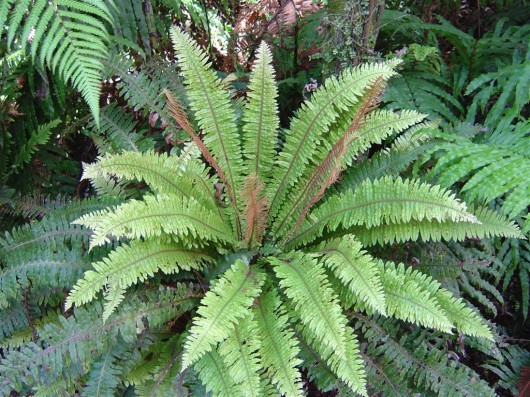 Crown Fern (Blechnum discolor)
Māori name is ‘Piupiu’ Crown Fern (Blechnum discolor)
Māori name is ‘Piupiu’
.
The koru (Māori for “loop”) is a spiral shape of a growing fern based on the shape of a new fern frond and symbolizing new life, growth, strength and peace.
.
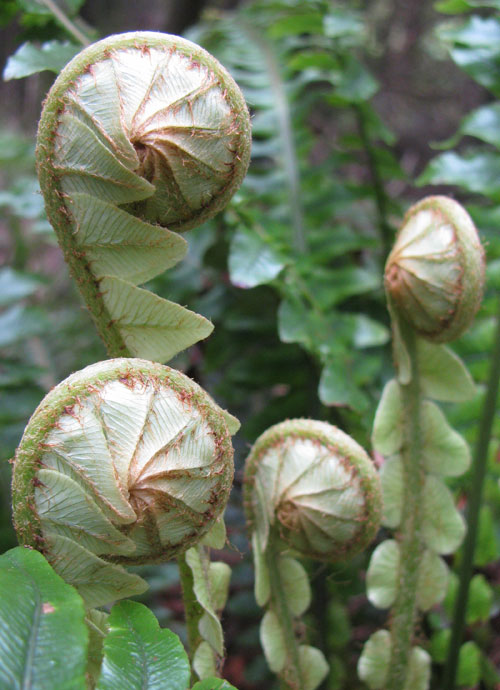 The ‘koru’ of New Zealand’s endemic Crown Fern
[Source: ^http://blogs.arcadia.edu/impactmagazine/files/2010/10/Plant-Blechnum-discolor-koru_500px.jpg] The ‘koru’ of New Zealand’s endemic Crown Fern
[Source: ^http://blogs.arcadia.edu/impactmagazine/files/2010/10/Plant-Blechnum-discolor-koru_500px.jpg]
.
Forest birds such as Tui, Korimako (Bellbird) and Kereru (New Zealand pigeon) migrate seasonally between coastal and upland forests. The Titi (Westland Petrel) colony south of the Punakaiki River is the only known place in the world where these burrowing seabirds breed. The birds live mostly out at sea, but during the breeding season you can see them flying to and from the colony at dusk and dawn. The nocturnal and secretive Great Spotted Kiwi (Roroa) is not often seen.
[Source: New Zealand Government, ^http://www.doc.govt.nz/parks-and-recreation/national-parks/paparoa/]
.
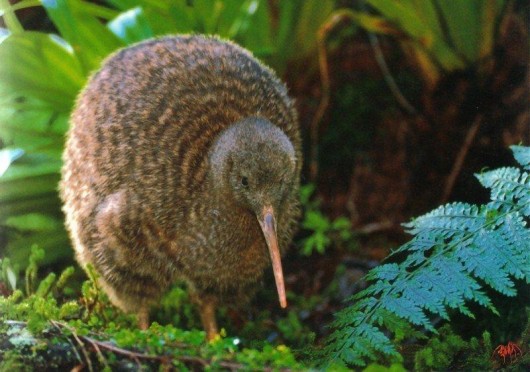 Great Spotted Kiwi, or Roroa (Apteryx haastii)
A rare species of kiwi endemic to the South Island of New Zealand – sadly classified as ‘nationally vulnerable’.
[Source: ^http://true-wildlife.blogspot.com.au/2011/05/great-spotted-kiwi.html] Great Spotted Kiwi, or Roroa (Apteryx haastii)
A rare species of kiwi endemic to the South Island of New Zealand – sadly classified as ‘nationally vulnerable’.
[Source: ^http://true-wildlife.blogspot.com.au/2011/05/great-spotted-kiwi.html]
.
Finders Keepers or Might is Right?
.
Native Māori tribe, the Ngāti Wairangi, had traditionally lived along the Te Tai Poutini (west coast) including in the area around Greymouth (the mouth of the Grey River).
Ancestrally, the tribe apparently originated from Hawaii in the 15th Century. But irrespective of ancestral authenticity, the native Māori Ngāti Wairangi lived around and called the river valley area Māwhera. Thankfully, due to the natural mountainous terrain dividing the east and west coasts, Ngāti Wairangi territory was protected for generations from invasive tribes.
It is generally recognised by New Zealand historians that the arrival of Māori to New Zealand included the introduction of the Polynesian Rat (Rattus exulans) known to the Māori as ‘kiore‘, which being prolific breeders would have had a devastating impact on native ground dwelling birds and small animals and reptiles. Similarly, it is generally recognised by New Zealand historians that the original eleven distinct species of Moa (endemic flightless birds) were hunted into extinction by the Māori by about 1400 AD.
A joint Māori and New Zealand Government sanctioned reported statement about the validity of such history would secure the truth, should such can be proven true. Myths can be dangerous.
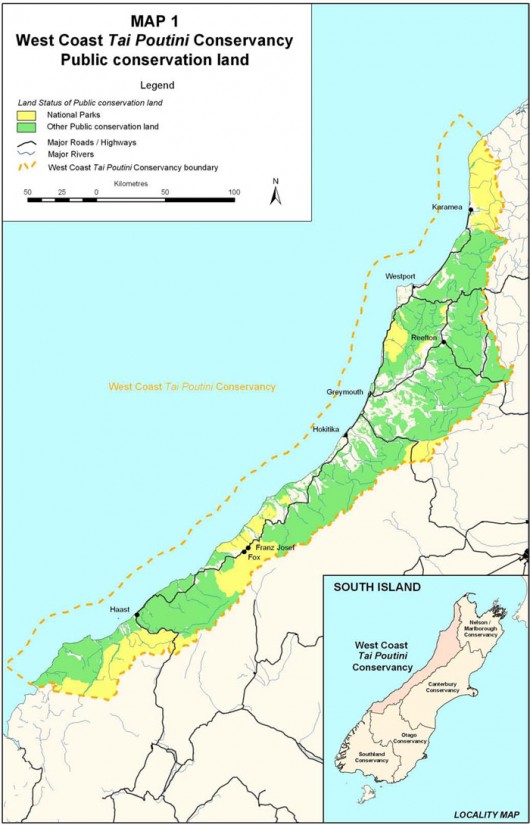 [Source: New Zealand Government,
^http://www.doc.govt.nz/publications/about-doc/role/policies-and-plans/conservation-management-strategies/west-coast/foreword/map-1/] [Source: New Zealand Government,
^http://www.doc.govt.nz/publications/about-doc/role/policies-and-plans/conservation-management-strategies/west-coast/foreword/map-1/]
.
‘Māwhera‘ (Greymouth area) became known for its Pounamu (precious and rare ‘greenstone‘, like jade). The unique nature of pounamu had a deep spiritual significance in Māori life and culture and was and remains highly prized. It naturally is found along the river bed of the Upper Arahura River around Greymouth, particularly at Kaikanohi, Pahutani, and at Kotorepi.
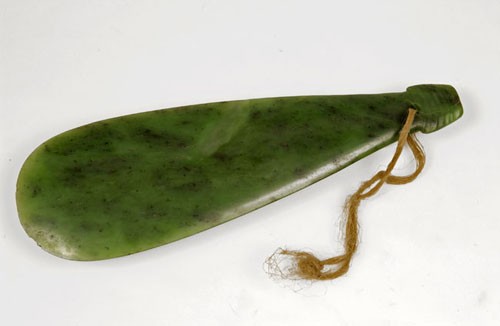 A Māori Mere Pounamu
a Greenstone traditional Māori club or ‘patu’ (‘mere’ meaning ‘weapon’)
The greenstone patu (‘mere pounamu’) is the most revered of all traditional Māori weapons and chieftainship.
[Source: National Army Museum Waiouru collection,
^http://www.nzhistory.net.nz/media/photo/greenstone-patu] A Māori Mere Pounamu
a Greenstone traditional Māori club or ‘patu’ (‘mere’ meaning ‘weapon’)
The greenstone patu (‘mere pounamu’) is the most revered of all traditional Māori weapons and chieftainship.
[Source: National Army Museum Waiouru collection,
^http://www.nzhistory.net.nz/media/photo/greenstone-patu]
.
Over time, the Ngāi Tahu tribe from the north learned about the pounamu and fought the Ngāti Wairangi for control of the stone. A number of battles ensued, and ultimately Ngāi Tahu wrested control of the resource from Ngāti Wairangi. This West Coast section of Ngāi Tahu became known as Poutini Ngāi Tahu, and it incorporated both Ngāi Tahu and the remnants of Ngāti Wairangi. Poutini Ngāi Tahu were then able to supply their eastern relations, and Kaiapoi became a focus of pounamu trading.
What happened to the Ngāti Wairangi and their land rights?
.
“There must be somebody there, because somebody must have said “Nobody.”
~ A.A. Milne, Winnie-the-Pooh
.
In 1846, English colonial explorer Thomas Brunner sailed to the area in 1846 and discovered coal along the Grey river valley. The area was soon settled and exploited by the English colonists, usurping themselves as ‘The Crown‘, and with coal mining industry taking off in the 1880s as well as gold mining and logging of the ancient native forests. Greymouth and the Grey River were duly named after a colonial governor of the British Empire.
By the 1860s, the English colonists, aserting themselves as ‘The Crown’, began intruding upon Ngāi Tahu’s access to pounamu. In 1874, a Dunedin based lapidary (gemstone) firm was purchasing the greenstone from Greenstone Gully near Greymouth, at £8 per cwt. In 1904, a Wellington Jeweller had paid to 5/- per lb for two tons of Westland greenstone to ship to lapidaries in Amsterdam, Holland, for shaping into Māori curios (tikis and the like) . In 1912, the amount of greenstone calculated as being able to be quarried at Tara Tame, Westland, amounted to 270,000 tons. Greenstone suitable for working was valued at from 1/-to 6/- per lb., or in bulk £56 to £672 per ton.
It wasn’t until 1997 under the Ngāi Tahu (Pounamu Vesting) Act that the New Zealand Government, asserting its absolute sovereignty, recognised the legal ownership of pounamu to Ngāi Tahu in its natural state and in Ngāi Tahu’s tribal area, including unsettled bits of the coastline.
[Source: Victoria University of Wellington Library, ^http://nzetc.victoria.ac.nz/tm/scholarly/tei-TayLore-t1-body1-d22.html; Te Ara – The Encyclopaedia of New Zealand, ^http://www.teara.govt.nz/en/pounamu-jade-or-greenstone/]
.
Meanwhile, colonists had introduced rats, stoats, possums, goats and deer to New Zealand and they flourished and wiped out many native fauna.
.
The Paparoa Range – mining the pristine
.

.
The coal deposits in the West Coast area are referred to as the Paparoa and Brunner Coal Measures, concentrated at Greymouth, Buller, Inangahua, Pike River and Stockton ‘coalfields‘. Two decades after Brunner discovered coal 7 km upstream from the mouth of the Grey River in 1864, coal mining begun at Coal Gorge (later called Brunnerton, then later just Brunner).
Once rail and ports were completed to Greymouth in 1882, large scale mining commenced and facilitated industrialised coal mining in the area. Coal mining has since been the dominant industry ever since, containing virtually all New Zealand’s bituminous (coking) coals.
On 26th March 1896, a tragic explosion deep in the Brunner Mine killed all 65 miners inside.
It seemed most likely that the explosion was caused by firedamp, a common hazard in bituminous (black) coal mines, where fammable methane gas accumulates under pressure in pockets in the coal and adjacent strata, and when penetrated accidentally ignites and explodes.
Extraction of bituminous coal demands the highest safety procedures involving attentive gas monitoring, good ventilation and vigilant site management.
The Brunner Mine Disaster was labelled the worst mining disaster in New Zealand’s history.
.
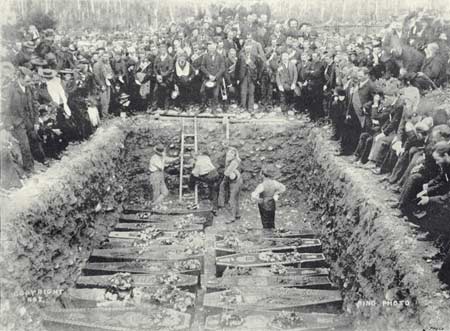 The 1896 mass grave for 33 of the 65 miners (men and boys) at Stillwater
[Source: Christchurch City Libraries, Ref. PhotoCD 2, IMG0073, ^http://christchurchcitylibraries.com/ The 1896 mass grave for 33 of the 65 miners (men and boys) at Stillwater
[Source: Christchurch City Libraries, Ref. PhotoCD 2, IMG0073, ^http://christchurchcitylibraries.com/
.
Coal production peaked in 1914, when 1.3 million tonnes were produced with 2550 employees. Following World War II there was a significant production decline as hydro-electricity and diesel fuel became more available. Loss of markets resulted in the closure of a number of mines.
Up to 1973, most coal was extracted by underground methods. In the Buller and Stockton coalfields, coal continues to be extracted by opencast mining, while underground methods are necessary for the deeper coal seams of the Greymouth Coalfield and more recently at Pike River.
.
Government Corporate Mining
.

.
Up until the 1980s, black coal from the Coast was used within New Zealand mainly for home and industrial heating (steam raising at dairy factories, as fuel at the Cape Foulwind cement works and in gas works).
Since 1987, the Stockton Mine, 80km north of Greymouth, has been operated by New Zealand Government-owned coal-mining company, Solid Energy, in a partnership agreement with Downer Australia.
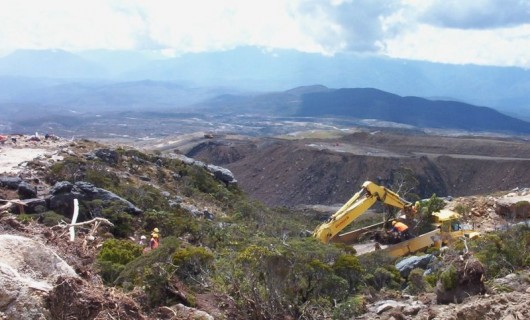 Stockton Opencast Coal Mine
Run by the New Zealand Government’s Solid Energy
80km north of Greymouth, New Zealand Stockton Opencast Coal Mine
Run by the New Zealand Government’s Solid Energy
80km north of Greymouth, New Zealand
.
Solid Energy remains New Zealand’s leading coal producer and the Stockton Coal Mine New Zealand’s largest opencast mining operation, with self-granted licence to operate for at least forty years to 2017 and beyond. Since 1990 around 90% of West Coast coal production has been exported for use as metallurgical coke in the steel making industry mainly in Japan, with the remaining 10% sold to industrial users and for electricity generation within New Zealand.
[Sources: New Zealand Government, ^http://www.mineralswestcoast.co.nz/westcoast_coal.aspx ; ^http://www.coalnz.com/]
.
Coal deposits have also been found in the Paparoa Range, including extensive seams in both the Greymouth Coalfield and the smaller, isolated Pike River Coalfield. Rail connections were built to provide access to the mines.
In 2009, New Zealand’s Government proposed opening up 7,000 hectares of high conservation land to prospecting for valuable minerals in the Paparoa National Park and in other parts of New Zealand, including on the Coromandel Peninsula and on Great Barrier Island.
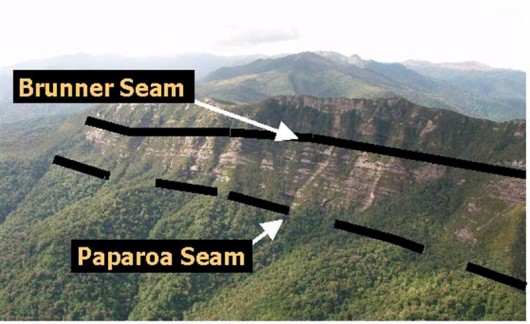 Coal Seams along the eastern side of the Paparoa Range
targeted by the New Zealand Government Coal Seams along the eastern side of the Paparoa Range
targeted by the New Zealand Government
.
Pike River Coal – Carter’s flawed compromise
.
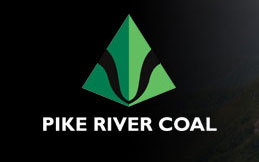 The marketing pike symbol
~ a symbol of socio-ecological arrogance above and beyond the River The marketing pike symbol
~ a symbol of socio-ecological arrogance above and beyond the River
.
In around 1996, Pike River Coal was set up by its mining founder, Gordon Ward, which became a subsidiary of New Zealand Oil and Gas (NZOG) subsidiary at the time.
The company was formed chiefly to exploit the Brunner Coal Seam comprising lucrative hard coking black coal under the Paparoa Ranges situated 80 km north-east of Greymouth. Hard coking coal is an essential ingredient in the steel making process and at the time the commodity price was high in international markets, particularly due to demand in booming industrial India and Japan.
Ward formed Pike River Coal for the business of mining and exporting at least 18 million tonnes of the 58 million tonne potential resource of the premium hard coking coal over a mine life of at least 18 years. The reserves lying in the Brunner coal seam are estimated to be the largest of their kind in New Zealand.
.
Politically, Pike River Coal was expected to earn around NZ$170 million in export income annually.
.
In 1996, after successful exploration and testing confirmed the potential resource under the Paparoa Ranges, Pike River Coal applied to the New Zealand Minister of Conservation to mine up to one million tonnes of coal annually inside the conservation area under the Crown Minerals Act.
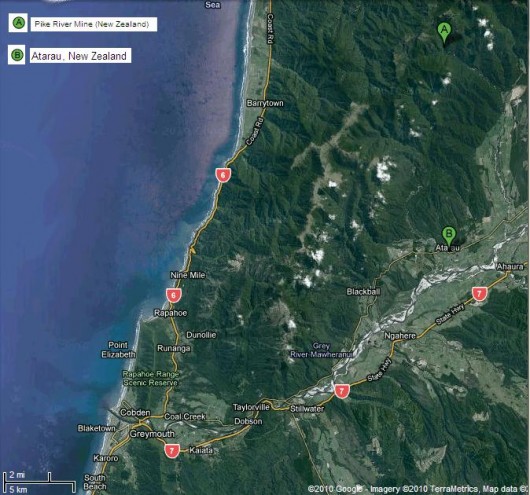
The application recognised the anticipated environmental pollution of acid mine drainage into the Pike River Catchment. Such sub-surface mining progresses below the water table, so water must be constantly pumped out of the mine in order to prevent flooding. After being exposed to air and water, oxidation of metal sulfides (often pyrite, which is iron-sulfide) within the surrounding rock and overburden generates acidity. Due to the sulphur-rich chemistry of the coking coal, the acidity draining out of subsurface coal mines is sulfuric acid which is highly toxic to river ecosystems.
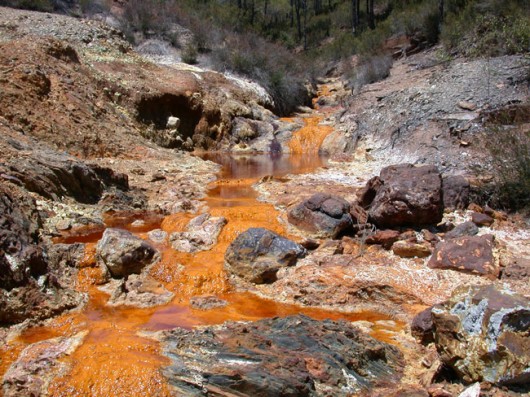 Example of Sulphuric Acid Mine Drainage in the Rio Tinto River (Spain)
What the New Zealand Government was keen to avoid by approving Pike River Mine Example of Sulphuric Acid Mine Drainage in the Rio Tinto River (Spain)
What the New Zealand Government was keen to avoid by approving Pike River Mine
.
So Pike River Coal offered the New Zealand Government $1.5 million in ‘compensation‘ to fund local environment and conservation programmes as well as associated ecological and biodiversity studies. This included setting up a pest control programme in the Pike River Catchment to help deal with the heavily infestation by the introduced pests – the Polynesian rats, stoats, possums, goats and deer.
[Source: ^http://www.proactiveinvestors.com.au/companies/news/9928/pike-river-coal-managing-director-gordon-ward-to-leave-9928.html]
.
Eight years later in 2004 the Minister of Conservation, Chris Carter, finally approved Pike River Coal access agreement to underground mine up to one million tonnes of coal annually from under the Paparoa Ranges.
Approval was granted despite the Department of Conservation Report to the Minister on the application indicating that the mining would be:
- inconsistent with objectives of conservation legislation
- inconsistent with purposes for which the land is held
- inconsistent with conservation management plans.
.
Further, there were concerns about adverse effects of acid mine drainage and the New Zealand Conservation Authority and the West Coast Tai Poutini Conservation Board objected to the mine.
To Carter, and the Labour Party Prime Minister of New Zealand at the time, Helen Clark, who had also held the portfolio of Conservation, clearly the money made it right – “…politics without principle, commerce without morality..” ~ Mahatma Gandhi.
.
Pike River Coal was expected to earn around NZ$170 million in export income annually.
.
According to the Department of Conservation Report to the Minister, the upper Pike River Catchment on the eastern side of the Paparoa Range is very high in conservation values.
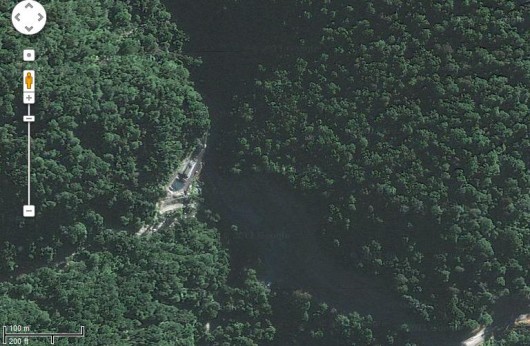 Pike River Mine – located deep in high conservation value native forest Pike River Mine – located deep in high conservation value native forest
A pristine site for a coal mine
.
- Pike River Catchment “is a relatively intact catchment” with high natural character and high “landscape and scenic values”
- It has “high quality aquatic habitat for threatened species such as:
- Blue Duck Māori name is ‘whio’ (Hymenolaimus malacorhynchos)
- Dwarf Galaxias (Galaxias divergens)
- Long Finned Eel (Anguilla dieffenbachii)
- “The catchment is the “habitat for ten known threatened species, including the Great Spotted Kiwi, Kaka and Kakariki”
(page 2)
.
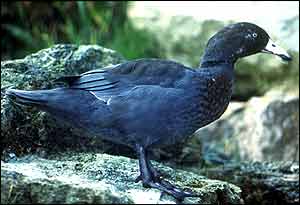 New Zealand’s blue duck: Predators and habitat loss mean rapid decline
[Source: Photo by Jonathan Leach, World Wildlife Trust,
^http://news.bbc.co.uk/2/hi/science/nature/2299547.stm] New Zealand’s blue duck: Predators and habitat loss mean rapid decline
[Source: Photo by Jonathan Leach, World Wildlife Trust,
^http://news.bbc.co.uk/2/hi/science/nature/2299547.stm]
.
 New Zealand’s endemic Blue Duck recognised on the NZ 10 dollar bill New Zealand’s endemic Blue Duck recognised on the NZ 10 dollar bill
.
The vegetation cover consists of a mosaic of five distinct types:
- Tall red tussock grassland
- Pink pine
- Leatherwood and dracophyllum mixed shrubland
- 300 year-old mountain and silver beech forest
- Mixed beech-hardwood forest with Kamahi, Rata, Tawherowhero
- Lowland beech-podocarp forest of Kamahi, Red Beech, Rimu
(page 5)
.
Approval of the Pike River Coal Mine inside a highly sensitive conservation value area, placed environmental constraints on the design of the mining infrastructure which should have flagged a risk assesssment by the mining management.
The ecological environment issues required restrictive mine access arrangements outside Paparoa National Park and limited drilling of ventilation holes. This apparently required the main drift tunnel to be drilled horizontally more than 2kms under the National Park in order to gain access to the coal resource. Normally mines are built atop the mineral to be extracted, if normal mining operations are being undertaking, thus boring down onto the resource, but also allowing lighter than air gases such as methane to escape vertically.
So desperate was Pike River Coal to proceed that this horizontal access design became the only mine in the world to have its entrance below the coal resource and so to mine upwards to the coal resources. Methane, a lighter than air gas had nowhere to go. There was clearly a degree of Titannic ego stubbornness in the venture, dismissive of the abnormal environmental conditions.
Approving Pike River Coal proceeed in high conservation, demanding high risk design was inherently flawed by compromise.
Was Pike River Coal’s decision to proceed an abject failure in operational risk management by informed qualified experts or by management overriding the operational risks in favour of the financial commitment and rewards. Another case of classic mining arrogance?
.
2004: Simon Johnson protests to NZ Minister of Conservation, Chris Carter
.
<<The Minister of Conservation
Chris Carter
c/- Parliament Buildings
Molesworth Street
Wellington
Fax: 04 472 8034
14 March 2004
Dear Mr Carter
Approval of access for Pike River Coal Company to conservation land
I understand that you have approved the application of Pike River Coal Company for access for mining within Paparoa National Park and other conservation areas.
I have to admit to being completely dumbfounded as to how approving mining in national parks and conservation areas can possibly further the purpose of conservation, preservation and protection. How could you possibly have approved mining in a national park? Why did you not simply decline the application?
Can I please register my utmost disapproval of this decision. If a Minister of Conservation from a Labour-led government cannot keep mining out of national parks then who will?
I request under the Official Information Act 1982 a copy of the record of your decision under the Crown Minerals Act that gives the reasons for this disappointing approval.
Yours sincerely
Simon Johnson
.
.
Chris Carter’s ‘ministerial’ reply:
.
Office of Hon Chris Carter
Minister of Conservation
29 March 2004
Dear Mr Johnson
Thank you for your correspondence, regarding the Pike River Coal Company’s application for access to operate a coalmine in the Pike Stream catchment in the eastern Paparoa Ranges.
I have approved in principle Pike River Coal Company’s application for an access arrangement to mine the coal deposits in the headwaters of Pike Stream on the West Coast.
My approval, however, is subject to the company and my department reaching a satisfactory agreement on the terms and conditions of the company’s access arrangements to the area, including financial assurances such as bonds and insurances.
This approval is conditional on my being satisfied that the terms of the access agreement achieve the higest possible environmental safeguards so that the conservation values of the area are protected as fully as possible.
I am aware that this mine does represent a significant intrusion into an area of high conservation values and a decision on whether to allow it to go ahead has been a very difficult one to make. I have considered the fact that the mine is mostly underground and its visual footprint and its visual footprint above ground is small (10 hectares) compared with the large area of protected landscape surrounding it (88,000 hectares). The lesser environmental impacts of underground mining have been recognised by environmental groups. The Royal Forest and Bird Protection Society, while critical of the Pike decision, has noted that, compared to opencast mining, underground mining reduces the impacts on the landscape, wildlife habitat, vegetation and public access. I agree.
I appreciate and can understand your concerns for the protection of public conservation lands. I agree that the Paparoa Range is an important area for nature conservation, recreation, tourism and for landscape protection. The significance of the Paparoa Range has been recognised over the years by successive Labour governments. This has included the formation of the Paparoa National Park, gazettal of a number of ecological areas and the Paparoa Wilderness Area, and ending all logging of publicly owned indigenous forests along the range and protecting these areas as public conservation land. These decisions were often made in the face of strong local opposition.
Direct human impacts on the heritage values of the public lands of the Paparoa Range, and of the West Coast generally, are at the lowest they have been in more than a century. I believe my conditional approval of this underground mine needs to be seen in this wider context.
Yours sincerely
Hon Chris Carter MP
Minister of Conservation
.
.
Chris Carter sends the decision making report:
.
Office of Hon Chris Carter
MP for Te Atatu
Minister of Conservation
8 April 2004
Dear Mr Johnson
Thank you for your letter of 14 March 2004, requesting a copy of the record of my decision under the Crown Minerals Act 1991, to conditionally approve Pike River Coal Company’s access arrangement application at Pike Stream on the West Coast.
Please find attached a copy of the relevant paper, excluding the financial amounts related to the proposed financial assurances, and excluding the compensation amounts that were not referred to in my media release of 12 March 2004. These financial amounts have been deleted under section 9(2)(k) of the Official Information Act 1982, to prevent the disclosure or use of official information for improper advantage.
With regard to the information I have withheld, I do not see that my reason for withholding the information is outweighed by other considerations which render it desirable, in the public interest, to make that information available.
You are entitled to seek an investigation and review of my decision by writing to an Ombudsman as provided by section 28(3) of the Official Information Act.
I have also enclosed a copy of the media release statement that went with my decision.
In your letter you refer to mining within a national park. Please note that this conditional mine approval does not provide for mining in the national park apart from the provision of four emergency exits.
Yours sincerely
Hon Chris Carter MP
Minister of Conservation
.
.
My letter requesting Chris Carter’s reasons:
.
The Minister of Conservation Chris Carter
c/- Parliament Buildings
Molesworth Street
Wellington
Fax: 04 472 8034
12 May 2004
Dear Mr Carter
Access for Pike River Coal Company to conservation land
Thank you for your letter of 29 March 2004 and for your letter of 8 April 2004 which enclosed the document “Pike River Access Arrangement” being the record of your decision under the Crown Minerals Act 1991 to conditionally approve Pike River Coal Company’s access arrangement application at Pike Stream on the West Coast.
I note that page 15 of this report states “The key issue for you to decide is whether the proposed partial safeguards and the compensation package offered, are sufficient to outweigh our concerns about the matters covered by section 61(2)(a), (b) and (c),”
Obviously you decided that the s 61(2)(d) matters outweighed the s 61(2)(a), (b) and (c) matters as you chose the option on page 16 to approve access.
I request under the Official Information Act 1982 your reasons for your weighting of the s 61(2) matters and for deciding on the option of approving conditional access.
Yours sincerely
Simon Johnson
.
.
Chris Carter’s reply:
.
Office of Hon Chris Carter
Minister of Conservation
19 May 2004
Dear Mr Johnson
In reply to your letter of 12 May 2004, I can advise that I decided that the section 61(2)(d) and (e) matters of the Crown Minerals Act 1991 outweighed the section 61(2)(a), (b) and (c) matters.
My decision was based on the information set out in the departmental submission and froma site visit. No arithmetical weighting was given to the matters to be considered under section 61(2); rather my decision was based on the totality of the evidence before me. The details of the proposed partial safeguards and the compensation package are set out in the departmental submission.
Yours sincerely
Hon Chris Carter MP
Minister of Conservation>>
.
[Source: ‘Letters to and from Carter about his softdoc decision to allow coal mines in the conservation areas in Pike Stream’, 20040313, by Simon Johnson, “Greenlight for new Coast coalmine”, in The Press, ^http://www.kapiti.co.nz/simonjohnson/mine5.htm]
.
.
2007: Pike River Coal cashed up and mining
Miner Gordon Ward, ahead of public listing on the New Zealand Exchange, became managing director and chief executive officer from May 2007 until significantly 1st October 2010, afterwhich Peter W. Whittall became Director and Chief Executive Officer of Pike River Coal Ltd. Two months later came the Pike River Mining Disaster.
The timing of Ward’s departure is interesting. Until his departure, Ward had led Pike River Mine from its initial conceptual design for some fourteen years since 1996, so why leave?
Other company directors included John Dow, Stuart Nattrass, Arun Jagatramka, Raymond F Meyer, Roy Antony Radford, and Dipak Agarwalla.
In July 2007, Pike River Coal Co Ltd launched on to the New Zealand Exchange to raise revenue through an Initial Public Offering (IPO), afterwich Pike River’s largest shareholder NZ Oil and Gas maintained its 29% stake, with Gujarat NRE Coke (7.14%), Saurashtra Fuels (5.5%) and the remaining equity spread across public stakeholders. Over $100 million was invested into the West Coast mine development and coal production commenced in October 2008 making Pike River Mine the second largest hard coking coal export mine in New Zealand.
It is located about 50km north-east of Greymouth in the west coast region of South Island. The mine is owned by Pike River Coal, the only listed coal mining and export company in New Zealand. The company is owned by New Zealand Oil & Gas (29%), Gujarat NRE Coke (7.14%) and Saurashtra Fuels (5.5%) and the remaining by public stakeholders.
The mining on Pike River Coal reserves was started in October 2008 by digging a 2.3km access tunnel under the Ranges for two years. The Brunner coal deposit seam runs 6.5km north-south (length), 1.5km east-west (width) and has a thickness of about 7m. The Brunner seam has estimated in-ground reserves of 58.5mt. The estimated recovery from the seam is 18mt over its 18-year mine life.
Paparoa seams lie about 200m beneath the Brunner seam. Initial drilling estimated an additional potential recovery of 8mt from this seam.
 Pike River Mine in operation Pike River Mine in operation
.
The Pike River used two mining methods which include creating roadways in the Brunner seam through large cutting machines and using hydraulic monitors to break the coal face. The mining was initially done using a NZ$5m road-header machine with tungsten tipped blades. The water cannons use high pressure blasting with water to break coal at a rate of 2,000 tonne/day. The crushed coal is then washed downhill through a 10km-long, low pressure, slurry pipeline to a processing plant.
A 10 km access road to the mine site was constructed in August 2006. In June 2008 TNL Group was contracted for trucking the hard coking coal processed at the Pike River coal preparation plant to the rail loadout facility at Ikamatua.
In late 2008, the mine’s ventilation shaft partially collapsed, delaying production and further production issues occured afterwards. An underground trench or ‘graben‘ was encountered immediately to the west and north of the pit bottom and Pike had to drill and blast through non-productive rock to get to the coal seam. Work began on a ventilation shaft that was 100 m deep, 4m diameter wide in 2008, but ran into ‘difficult rock conditions’. Before reinforcement of the shaft could be completed, the walls of the shaft collapsed.
At coal mine working faces, simultaneous application of three basic elements reduces the methane explosion hazard: (1) adequate ventilation, (2) regular monitoring of gas concentrations, and (3) the elimination of ignition sources. [Source: ^http://www.cdc.gov/niosh/mining/works/coversheet1682.html]
Still, within a month in January 2009, a NZ$20 million coal preparation plant was constructed and by mid-2009 production of hard coking coal from Pike River Mine had started. By February 2010 the first export shipment of 20,000 tonnes was made to coking plants in India for steel production. Mining financial management had overruled mining operational management absolutely and irresepectively.
[Sources: ‘Pike River Mine, New Zealand’, ^http://www.mining-technology.com/projects/pikeriverminenewzeal/; [Source: ^http://www.proactiveinvestors.com.au/companies/news/9928/pike-river-coal-managing-director-gordon-ward-to-leave-9928.html; ‘The making of Pike River’, by Alistair McKenzie, Q&M Vol.7 No.1 February-March 2010, Contrafed Publishing, ^http://www.contrafedpublishing.co.nz/QM/February-March+2010/The+making+of+Pike+River.html]
.
May 2010: New Zealanders stand against mining Paparoa Range
.
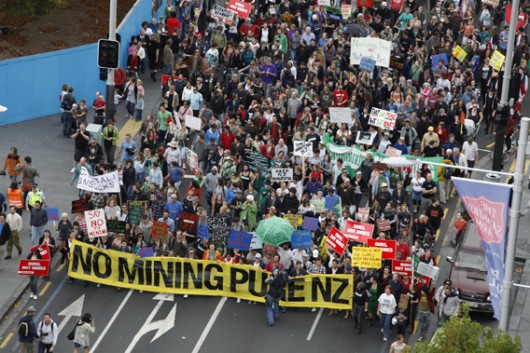 The people of New Zealand protest along Queen Street, Auckland on 1st May 2010
Some 40,000 New Zealanders very publicly were prepared to challenge government
for its flawed compromise between conservation and mining. The people of New Zealand protest along Queen Street, Auckland on 1st May 2010
Some 40,000 New Zealanders very publicly were prepared to challenge government
for its flawed compromise between conservation and mining.
“No Mining Pure New Zealand”!
[Source: ^http://lucylawless.net/events/2010/marchagainstmining010510/]
.
In May 2010, 40,000 New Zealanders protested a “No Mining” message to ask their government to simply respect New Zealand. This was the largest grassroots protest by New Zealanders in a generation.
.
.
Nov 2010: Tragedy
.
Later that year on 19th November a methane explosion inside the mine trapped 31 miners and contractors. Two managed to escape. The remaining 16 miners and 13 contractors ‘the twenty-nine‘ didn’t.
Following a second explosion five days later, the 29 remaining men were believed by police to be dead. They remain there.
.
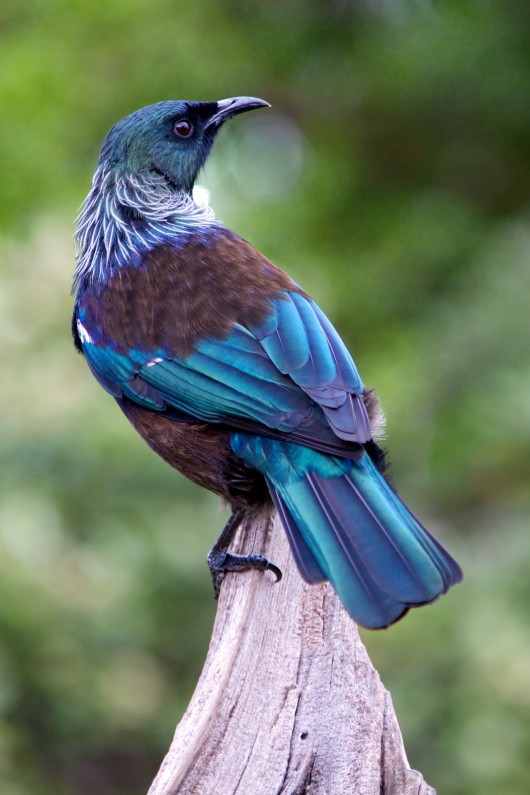 Tui
(Prosthemadera novaeseelandiae)
An endemic honeyeater of New Zealand
[Source: ^http://msf2011.blogspot.com.au/2012_03_01_archive.html] Tui
(Prosthemadera novaeseelandiae)
An endemic honeyeater of New Zealand
[Source: ^http://msf2011.blogspot.com.au/2012_03_01_archive.html]
.
Tags: Cave Creek, Crown Fern, Downer Australia, Great Spotted Kiwi, Greymouth, Kereru, kiore, Korimako, koru, Māori, New Zealand, Ngāti Wairangi, Paparoa National Park, Paparoa Range, Pike River Coal, Pike River Mine, Podocarp Hardwood Forest, Poporari River, Solid Energy, Tai Poutini, Tui
Posted in Threats from Mining | No Comments »
Add this post to Del.icio.us - Digg
Thursday, April 18th, 2013
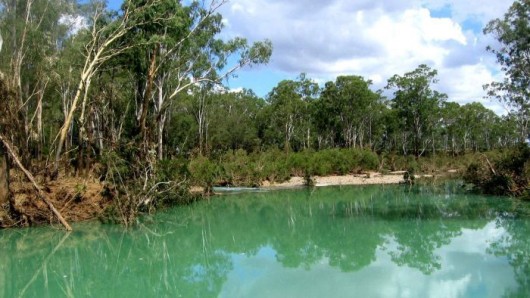 The Dee River at Dululu, 55km downstream from the Mount Morgan mine, North Queensland.
The aqua colour is due to heavy metal compounds polluting the river.
[Source: (Photo by Ian Townsend), ‘Toxic mine water’, ABC Radio National programme, 20130217,
^http://www.abc.net.au/radionational/programs/backgroundbriefing/2013-02-17/4513916] The Dee River at Dululu, 55km downstream from the Mount Morgan mine, North Queensland.
The aqua colour is due to heavy metal compounds polluting the river.
[Source: (Photo by Ian Townsend), ‘Toxic mine water’, ABC Radio National programme, 20130217,
^http://www.abc.net.au/radionational/programs/backgroundbriefing/2013-02-17/4513916]
.
Mining companies are perhaps the worst form of entity that perpetuates in modern industrial society to inflict ongoing narcisistic destruction upon the Natural landscape.
Mining companies employ consultants to window dress their activities with the effect of putting lipstick on a pig. They rape pillage and plunder the landscape with impunity because of corrupt governments sharing financial vested interests in the booty. Mining companies before, during and after their nefarious operations have no concern for the irreversible damage to ecology and landscape, but only for the profit promise. They are a relic of the 19th Century with the same immorality as the corporate slave traders.
As Mount Lyell in Tasmania remains the moonscape legacy of 19th Century mining, then in Mount Morgan is its sister mining moonscape.
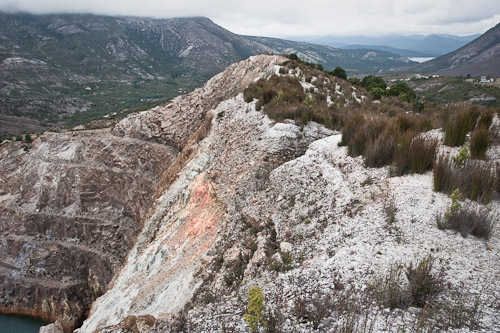 ‘Iron Blow Mine’
Mount Lyell’s copper mining legacy of West Coast Tasmania
(Photo by Gary Sauer-Thompson) ‘Iron Blow Mine’
Mount Lyell’s copper mining legacy of West Coast Tasmania
(Photo by Gary Sauer-Thompson)
.
Both have irrevocably destroyed all ecology for miles and contaminated river systems with heavy metals and lethal toxins. Both made their mining companies, mining magnates and complicit investors millions. Both were abandonned when the ore ran out and the taxpayer has been left to pay for the clean up if ever that could be possible.
And mining companies complain when there is suggestion of a mining tax. Beyond a mining tax, mining companies in the 21st Century need to be held accountable for their impacts before they dig the first sod. There needs to be a compulsory bond required from mining companies up front to sufficiently cover the complete remediation of the site according to scale and risk. Instead of the artificial obscene profit skimming by management and investors that currently ignores the real cost of mining on the landscape, it would bring the profits from mining more in line with corporate social responsibility.
The Dee River is a river in Central Queensland, Australia. The Dee is a tributary of the Dawson River, itself a tributary of the Fitzroy River. The mining town of Mount Morgan is located on the river. It is crossed by the Burnett Highway a number of times. The Dee River rises in the Razorback Range south of Bouldercombe Gorge Resources Reserve near Bouldercombe. Tributaries include Limestone Creek, Horse Creek, Hamilton Creek and Nine Mile Creek on the left while Boulder Creek, Oaky Creek and Pruce Creek enter from the right. The Dee River joins the Don River near Rannes.
But Queensland’s Dee River is being killed by toxic water from the old gold mine of Mount Morgan – and is one of thousands of abandoned and unregulated mine sites, many of which are leaking contaminated ‘legacy water’ into river catchments.
 In this picture you can see the acid mine water gushing out the side of the mine pit.
(Photo by Ian Townsend, February 2013) In this picture you can see the acid mine water gushing out the side of the mine pit.
(Photo by Ian Townsend, February 2013)
.
The largest dam on the Dee River is in mining accounting lingo, ‘Number 7 Dam‘, built for the Mount Morgan Mine.
 Number 7 Dam Number 7 Dam
Mount Morgan Mine in 2011
Lies right next to the Mount Morgan township
.
Mount Morgan Mine has been a copper, gold and silver mine in northern Queensland, Australia since 1882 up until 1981. Over its lifespan, the mine yielded approximately 262 tonnes of gold, 37 tonnes of silver and 387,000 tonnes of copper and was once the largest gold mine in the world.
Mount Morgan Limited progressively scaled back its workforce and operations until it reached the end of its ore body in 1981. Since 2007, the mine and mining leases have been owned by Norton Gold Fields and an estimated 327,000 ounces of gold still apparently exists at the site.
Concerns regarding the discolouration of the river’s water and fears of contamination causing irreversible damage to the river were raised back in mid 2011.

In January 2013, the mine pit overflowed… and 700 mm of rain fell after ex-tropical Cyclone Oswald resulted in the 2013 Eastern Australia floods.
Towards the end of February the dam was still spilling acid and heavy metals into the river, and probably continues at the time of writing.
.
 The Dee River at Mount Morgan is highly acidic.
Here the river is badly contaminated with heavy metals, staining the rocks and producing a sludge in the river.
(Photo by Ian Townsend, February 2013) The Dee River at Mount Morgan is highly acidic.
Here the river is badly contaminated with heavy metals, staining the rocks and producing a sludge in the river.
(Photo by Ian Townsend, February 2013)
.
Contamination fears for Dee River
.
<<Calls have been made for a full investigation into pollution in the Dee River, with fears of contamination from nearby closed mines.
The Queensland member for Mirani, Ted Malone, said he is worried that the Dee River’s very blue-green colour is unnatural and that something is very wrong with the waterway, according to The Morning Bulletin.
Malone called for a comprehensive inquiry into contaminated water leaking into the river from the Mount Morgan mine, and to identify it as an environmental hazard.
“With controlled releases of highly contaminated mine water this year, as well as seepage offsite, the Dee is in a contemptible state. It is void of life and lined with a precipitate containing heavy metals and it will soon be past the rehabilitation stage if the government does not step in and fully rehabilitate the mine site,” chairman of the Wowan/Dululu Landcare Group, Neal Johnson, said.
These calls come after the QLD Government announced a boost in funding for the rehabilitation of the Mount Morgan and Mount Oxide mines. It announced $24.2 million in funding to ensure the safe management and rehabilitation of historic mine sites.
Mining minister Stirling Hinchliffe stated that historic mines such as Mt Morgan and Mt Oxide are a legacy of old mining practices and need safe management.
“This is Government is committed to managing problems caused by past mining practices,” Hinchliffe said. “Problems with old and outdated mining practices were created over many years and will take many years to address but we won’t shy away from that. That’s why we’re investing a further $24.2 million over four years for mine management and rehabilitation, $6 million of this operational and capital funding will be invested during 2011-12.”
However, Queensland senator Barnaby Joyce stated that the government has failed to address the issue of contaminated water in Mt Morgan’s pit lake. He said the pit lake is almost full and could leak into the Dee River, exacerbating residents concerns of contamination.
Joyce did state, following the funding, “thankfully now they are doing something”.
QLD mines minister Stirling Hichliffe stated that the government had also just completed a $1.8 million upgrade of the Mt Morgan mine water treatment plant to increase capacity to one billion litres each year, to allay fears of uncontrolled releases.>>
.
[Source: ‘Contamination fears for Dee River’, 20110725, by Cole Latimer, ^http://www.miningaustralia.com.au/news/contamination-fears-for-dee-river]
.
“I never wonder to see men wicked, but I often wonder to see them not ashamed.”
~ Jonathan Swift (1667-1745)
.
Tuesday, April 16th, 2013
 . .
<Federal environment minister Tony Burke has rejected National Heritage listing for Tasmania’s precious Tarkine Wilderness.
.
Burke’s Ten New Mines!
.
On 8th February 2013, Burke announced 10 new mines proposed over the next five years for the Tarkine Wilderness. Nine of these 10 mines will be open cut leaving scars of devastation in an area of north-western Tasmania.
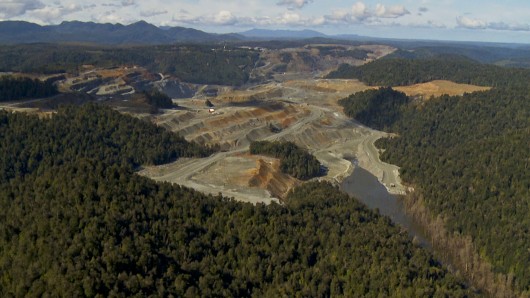 Savage River Mine already scarring The Tarkine Wilderness Savage River Mine already scarring The Tarkine Wilderness
.
“The Tarkine is one of the world’s great wild places.
It is an expansive 447,000 hectare wilderness area of recognised World Heritage significance in the North-West corner of Tasmania, Australia’s island state. The Tarkine contains remarkable natural and cultural values, including one of the world’s most significant remaining tracts of temperate rainforest,” said the Tarkine National Coalition.
The Tarkine is a place of unique natural and cultural significance and was nominated for World Heritage listing by the Australian Senate in 2007.
The Tarkine has been recognised by prominent bodies including the International Union for the Conservation of Nature, the Tasmanian Department of Parks, Wildlife and Heritage and environment groups such as The Wilderness Society and the Australian Conservation Foundation.
The Australian government has recognised the Tarkine’s outstanding national significance through listing the Tarkine on the register of the National estate.
As the Tarkine National Coalition says:
.
Burke only “listed a paltry 4% of the 433,000 hectares recommended to him by the inquiry”
.
Since February 8, Burke has granted the first two of 10 mining permits to Venture Minerals for three iron mines at Mount Lindsay and granted Shree Minerals an iron ore mine proposed for Nelson Bay River.
Successive environment ministers have failed to put forward an assessment by the Australian Heritage council for Heritage listing with UNESCO leaving these areas of “outstanding natural and cultural value” vulnerable to the policies of Burke.
A national day of action on 14th February 2013 and a campaign in local media helped to expose the plight of the now endangered Tarkine and reverse this environmentally catastrophic decision.
Venture Minerals and Shree Minerals are driven by the profits to be made from these proposed mining ventures in the Tarkine. But the Tarkine has far more long-term value as a wilderness area and should continue to benefit all.>>
.
[Source: ‘Mining approved in the Tarkine’, 20130219, by Rachel Christensen, ^http://www.greenleft.org.au/node/53374]
.
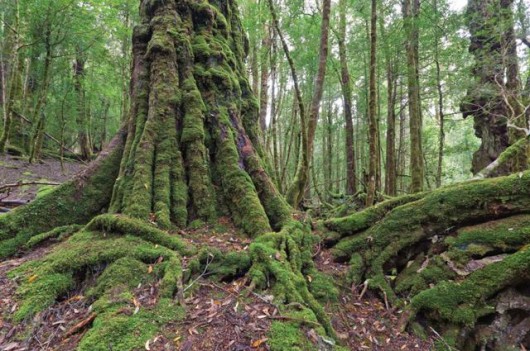 Tarkine Wilderness
(Peter Walton, Tasmania Expeditions) Tarkine Wilderness
(Peter Walton, Tasmania Expeditions)
.
So in the absence of government responsibility, Dr Bob Brown has just been announced as new patron of rebranded Save the Tarkine campaign.
The Tarkine National Coalition is pleased to make two exciting announcements that we believe will help increase the national profile of this important campaign.
“Today we are unveiling the new Save the Tarkine branding that we will campaign under”, announced Campaign Coordinator, Scott Jordan. “We believe that brand, Save the Tarkine will help the public more easily identify this important campaign, and let them know in clear terms what our mission is.”
To support this rebranding, a new Tasmanian devil inspired logo has been adopted (see above).
Tarkine National Coalition Incorporated remains as the registered legal entity, with campaigns to be conducted under the registered trading name Save the Tarkine.
Save the Tarkine are also thrilled to announce that Dr Bob Brown has accepted our invitation to become patron of the campaign.
“Bob is no stranger to the Tarkine, having fought for it’s protection both in and out of the parliament. We are thrilled that Bob has agreed to accept the role of patron, and we look forward to sharing Bob’s passion for the Tarkine with all of Australia”.
“I’m honoured to be first patron of Save the Tarkine”, said Dr Brown in Launceston. “I first walked the Tarkine forty years ago looking for Tasmanian Tigers, and if protected the Tarkine will create hundreds, if not thousands of jobs in the future. If mined it will end up another post-industrial waste dump”.
.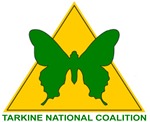 . .
 . .
<<The Tarkine is a vast, continuous and largely untouched wilderness of exceptional and rare diversity. Covering an area of around 450,000 hectares in Tasmania’s north-west, it is a place worthy of World Heritage protection yet, unbelievably, remains inadequately protected and vulnerable to being carved up by the mining and forestry industries.
This book is the authors’ tribute to this last of the last frontier experiences on earth.>>
.
‘Tarkine – Wild and Sacred’
by S & E Bartley
40 Degrees South Publishing
RRP:$29.95 Paperback 144 pp
ISBN 9780987243195
.
[Source/Purchase: ^http://www.fortysouth.com.au/writers-market/book/161]
.
Tags: Bob Brown, Mount Lindsay, Nelson Bay River, save the Tarkine, Shree Minerals, Tarkine wilderness, Tasmania, Tasmanian Tarkine, Tin Mining, Tony Burke, Venture Minerals
Posted in Tasmania (AU), Threats from Mining | 2 Comments »
Add this post to Del.icio.us - Digg
Sunday, November 11th, 2012
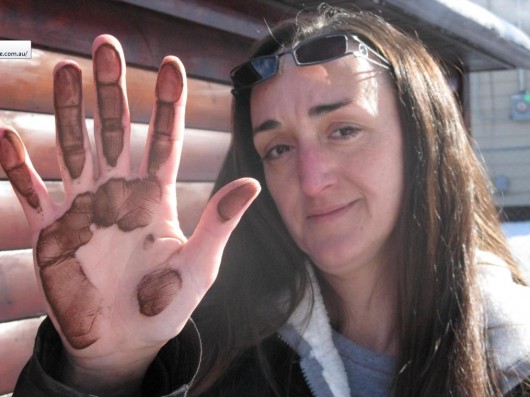 Lessons from coal mining destruction of the Appalachian Mountains and its people Lessons from coal mining destruction of the Appalachian Mountains and its people
2010 West Virginia, United States of America
.
<<Maria Gunnoe is a community member and organizer for the Ohio Valley Environmental Coalition. Here, she displays the coal dust wiped from Frankie Mooney’s garage in Twilight, West Virginia. The nearby blasting routinely fills the air with coal dust clouds, which then settle on buildings and turn air filters black. If Massey had its way, Twilight would become the next Lindytown – but Frankie’s property is closest to the company land and his refusal to sell protects the rest of Twilight from destruction.>>
[Source: ‘Stand with Coalfield Residents at Appalachia Rising‘, by ‘Carolyna’, 20100917, ^http://members.greenpeace.org/blog/carolyna/]
.
‘New report highlights health fears for Hunter Valley’
[New South Wales, Australia]
[Source: ‘New report highlights health fears for Hunter Valley’, 20121029, Australian Broadcasting Corporation, ^http://www.abc.net.au/news/2012-10-29/new-report-highlights-health-fears-for-hunter-valley/4338446]
.
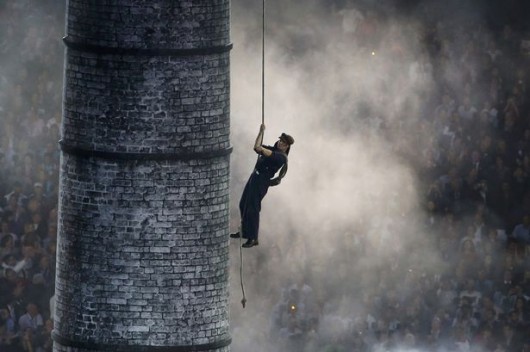 A Dickensian Industry
[Source: The 2012 London Olympics, ^http://www.mirror.co.uk/news/uk-news/london-2012-opening-ceremony-opinion-1176668] A Dickensian Industry
[Source: The 2012 London Olympics, ^http://www.mirror.co.uk/news/uk-news/london-2012-opening-ceremony-opinion-1176668]
.
<<Health authorities are coming under pressure to properly investigate the health impacts of mining on Australia’s largest coal mining region, in the New South Wales Hunter Valley.
It comes after new research showing a link with increased death rates and disease in some other countries.
Sydney University’s Associate Professor Ruth Colagiuri analysed research from 10 countries including the USA and the UK. She says coal mining communities there had elevated rates of cancer and higher death rates from illnesses such as heart, lung and kidney disease. Birth defects were also more prevalent.
 Deadly Coal Dust Deadly Coal Dust
.
Professor Colagiuri:
- There are clear indications of serious health issues associated with coal mining and coal-fired power plants for surrounding communities. But.. there has been no such research done in the Hunter Valley.
- We have very little in Australia on the health harms at all. I guess until we have our own studies we don’t know for sure but it would be silly to think that some of the evidence is not applicable here, particularly if it’s not from the countries that are more applicable to Australia, culturally and economically.
- It is time to gather the evidence, so (that) judgments can be made…about whether the harms we’re finding in the international literature do apply to Australia.
.
The Cancer Council’s head Ian Oliver agrees: “The people who live in these areas need to be aware of whether the same thing applies here,” he said.
Sydney University’s independent research was commissioned by environmental group, Beyond Zero Emissions.
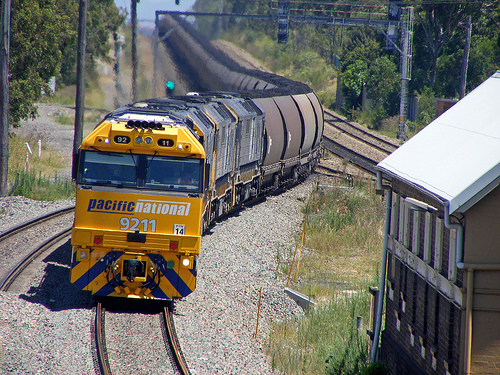 Hunter Valley Coal Train
[Source: Photo by Vince Wang
^http://www.railpage.com.au/f-t11342636-s30.htm] Hunter Valley Coal Train
[Source: Photo by Vince Wang
^http://www.railpage.com.au/f-t11342636-s30.htm]
.
The Chairman of a Hunter Valley health lobby group has described as ‘unconscionable’ the lack of research by both State and Federal Governments into the health impacts of mining.
Dr John Drinan from the Singleton Shire Healthy Environment Group says the latest report just reinforces what Hunter mining communities have been calling for.
“It really is unconscionable that governments have allowed this sort of thing go on for years knowing full well there are implications of coal mining on health,” he said.
“Here we are in the Hunter Valley generating billions of dollars a year for the Government coffers, yet they’ve seen no need to put any effort back into finding out whether this has any deleterious impacts on our health.”
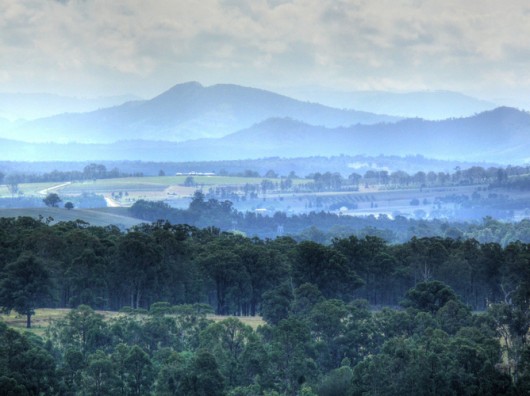 Coal mining in NSW’s Hunter region co-exists with wine growing, racehorse breeding, dairy and other pastoral industries.
[Photo by Jo Schmaltz]. Coal mining in NSW’s Hunter region co-exists with wine growing, racehorse breeding, dairy and other pastoral industries.
[Photo by Jo Schmaltz].
.
‘Research needed into Hunter’s coalmines’
[Source: ‘Research needed into Hunter’s coalmines’, by Ian Olver, The Herald (newspaper), 20121102, ^http://www.theherald.com.au/story/524537/opinion-research-needed-into-hunters-coalmines/]
.
Cancer Council Australia chief executive, Professor Ian Olver:
<<I did not expect the lecture room at the University of Sydney to be overflowing for the release of a report on the impact of coalmining. But it was.
The group Beyond Zero Emissions had commissioned Ruth Colaguiri’s group at the university to review all the research in Australia and overseas on the effect of coalmining on local communities. They were particularly worried about the Hunter Valley – and with reason.
.
The population of 700,000 lives in a region that has more than 30 open-cut coalmines and six coal-fired power stations.
.
As I left the launch of the report I fell into step with a person from the area. He told me his village was next to go. An open-cut mine was coming.
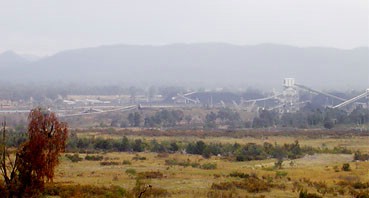 Dust clouds the view of the Ulan Mine conveyor belts
(North west of Mudgee, NSW) Dust clouds the view of the Ulan Mine conveyor belts
(North west of Mudgee, NSW)
.
I asked about compensation, but, more resigned than angry, he told me that he was to receive none. He couldn’t sell, because who would buy with the mine approaching?
A mine worker for years, he would have to stick it out on his few acres growing grapes with an open-cut mine for a neighbour, located within a few kilometres.
The University of Sydney researchers reviewed 38 studies:
.
‘Data from Appalachian coalmining counties in the United States or areas in Nova Scotia, Canada, most nearly paralleled local conditions. Adults living in coalmining communities had higher rates of lung, heart and kidney disease and lung cancer. Hospitalisations for chronic lung disease increased with the amount of coal mined…’
.
Children had more asthma and higher levels of lead and cadmium in their blood. There was a higher incidence of some birth defects.
It was a similar story for those living near coal-fired power stations, with adults having a higher death rate from cancers of the lung, head, throat, bladder and a higher incidence of skin cancer and children have more breathing difficulties. They also reported more miscarriages. People living in these areas score lower on assessments of their quality of life.
Why would these illnesses occur?
Each stage of coal production – mining, transport, washing, burning the coal and disposing of the waste products – releases particles into the environment that have the potential to cause harm if the level of exposure is high and prolonged. Burning coal makes a contribution to greenhouse gases. Waste products including heavy metals have the potential to contaminate the water supply.
So what about in the Hunter Valley? Are the same health problems reported there?
We don’t know. The detailed research needed has not been done. The main thrust of the report is that we need to collect evidence so the extent of the health impact is known. Anecdotes are not sufficient. But the overseas studies give us a strong reason to push for local studies.
What we do know is that 16% of the Upper Hunter Valley consists of open cut coalmines and massive expansion is planned. It is only recently that the NSW Government has set up a network of stations to monitor particle pollution of the air. To be most valuable they will need to report each occasion when particle levels exceed acceptable limits and how frequently, rather than averages.
The report went further than documenting the health and environmental impacts of living near coalmines and coal-fired power stations. It also documented the adverse social impact on the surrounding communities.
This time there were studies from the Hunter Valley.
.
‘There is an injustice if people do not know the potential extent of the environmental damage, poor air and water quality and how it may damage their health.’
.
However, we need to know details about the levels of exposure to pollutants from mining in the Hunter and whether they are causing an increase in illness before we can ask the governments or the industry to increase protection. Communities become distressed by being disempowered and not being able to influence the changes that are reducing their living standards, and influencing their access to natural resources.
There is no doubt about the need for power production, but this needs to be balanced against harms to local communities. Diseases such as lung cancer are difficult to treat and we must seize upon any opportunity for prevention. Individual stories may raise awareness, but advocacy for change must be based on solid evidence and we must do the Australian research into the health impacts of coalmining on local communities to help us achieve a just balance.>>
.
Black Lung – centuries change but Coal Dust doesn’t
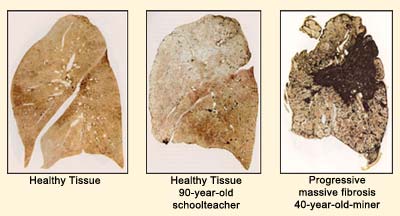 <<‘Black Lung’ is a legal term describing a preventable, occupational lung disease that is contracted by prolonged breathing of Coal Mine Dust. Described by a variety of names, including: <<‘Black Lung’ is a legal term describing a preventable, occupational lung disease that is contracted by prolonged breathing of Coal Mine Dust. Described by a variety of names, including:
- Miner’s Asthma
- Silicosis
- Coal Workers Pneumoconiosis
- Black Lung
.
.. all are all dust diseases with the same symptoms.
.
Like all occupational diseases, black lung is man-made and can be prevented. In fact, the U.S. Congress ordered Black Lung to be eradicated from the coal industry in 1969. Today, it is estimated that 1500 former coal miners each year die an agonizing death in often isolated rural communities, away from the spotlight of publicity.>>
[Source: United Mine Workers of America,^http://www.umwa.org/?q=content/black-lung]
.
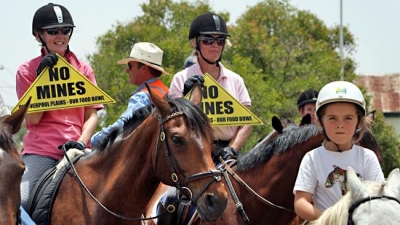 Protesters on horseback take to the streets in November 2009 to voice concerns over the proposed Bickham coal mine (Hunter Valley)
Friends of the Earth Sydney congratulates Pages River and Tributaries Water Users Association and Rivers SoS Alliance in their successful campaign to stop the proposed Bickham open-cut coal mine and save the Pages River (near Scone in the NSW Hunter Valley). Protesters on horseback take to the streets in November 2009 to voice concerns over the proposed Bickham coal mine (Hunter Valley)
Friends of the Earth Sydney congratulates Pages River and Tributaries Water Users Association and Rivers SoS Alliance in their successful campaign to stop the proposed Bickham open-cut coal mine and save the Pages River (near Scone in the NSW Hunter Valley).
[Source: Friends of the Earth Sydney,
^http://www.sydney.foe.org.au/news/nsw-government-rejects-coal-mine-first-time-ever]
.
‘Coal industry thriving, but at what social and health cost?’
[Source: ‘Coal industry thriving, but at what social and health cost?’, by Ruth Colagiuri, Emily Morrice, The Conversation, 20121102, ^http://theconversation.edu.au/coal-industry-thriving-but-at-what-social-and-health-cost-9266]
.
<<If you believe industry propaganda, coal mining is a panacea not only for economic ills but also for smoothing troubled social waters. But a lack of local evidence about the health impact of the coal industry should give us all cause for thought.
With the highest density of coal mining activity close to towns and farms in Australia (well over 30 operating mines and six active coal-fired power stations, and the largest black coal exporting port in the world), many Hunter Valley residents remain unconvinced. Less than a two-hour drive north of Sydney, in one of the largest, most fertile, beautiful river valley systems in Australia, the Hunter region’s long tradition of coal mining has co-existed for many decades in balance with wine growing, racehorse breeding, dairy and other pastoral industries.
But the seemingly indiscriminate granting of mining licences by the previous state government (and little abatement likely under the current government) has put a major strain on relations between the mining industry, other local industries and the citizenry.
This is unsurprising considering inequities such as water rights favouring the coal industry over local farmers, the removal of local government input from the coal mine licensing process, and concerns about the transgenerational effects of irreparable environmental damage.
And then there’s health. Ongoing concerns and myriad anecdotal reports of serious health impacts have been expressed by both local communities and health professionals, and echoed by organisations such as Doctors for the Environment. But there’s virtually no hard evidence in the peer-reviewed literature to confirm or deny the negative health impacts on communities near coal mines or coal-fired power stations in Australia.
Such evidence is available in other countries and is summarised in a new independent report that cites 50 articles exploring the health and social harms of coal on community health from 13 countries. And it’s not pretty.
.
Health and Social Harms of Coal Mining in Local Communities:
.
Spotlight on the Hunter Region cites excess deaths from lung cancer, chronic heart, respiratory and kidney disease related to living near coal mines. The evidence is mostly from the United States and often features a dose-response effect related to coal quantity or surface area of the mine. Other effects include high blood levels of heavy metals in children, and higher rates of birth defects.
Living near coal combusting power plants is associated with excess death – in this case from lung, laryngeal and bladder cancer. Respiratory complaints, increases in non-melanoma skin cancers, still births and miscarriages are also reported.
So how alarmed should Australians be? The problem is we don’t really know. Mining methods, practices and regulatory controls vary across countries and may account for some of the reported health effects. As may factors such as difficulties in accurately measuring exposures to toxins and particulate matter in air pollution.
Despite these limitations, it would be irresponsible to ignore the possibility that some of the effects demonstrated in similar countries are likely to apply here.
The lack of local evidence in itself is alarming – particularly at a time when NSW Health is believed to be investigating a cancer cluster in the Illawarra mining region of the state. Six children living in close proximity are said to have developed either leukaemia or a lymphoma in the past five years.
A report by the Australia Institute and many other technical reports on the coal industry point out that externalities are rarely included in cost estimates of the benefits and harms of coal extraction and combustion. These factors include environmental damage, social costs such as tax subsidies to the industry (of up to $10 billion annually) and health harms estimated by the Australian Academy of Technological Sciences and Engineering(ATSE) at $2.6bn annually.
Nonetheless, major developments in the coal mining industry are underway. Massive expansion of the port of Newcastle – already the world’s biggest black coal exporting port – is in planning stages. Commonly referred to as the “T4” Project, Port Waratah Coal Services propose expanding their Kooragang terminal in Newcastle in order to increase coal exports by up to 120 million tonnes a year.
 CNA Coal, Muswellbrook
Hunter Valley CNA Coal, Muswellbrook
Hunter Valley
.
Further coal port expansions are also planned by North Queensland’s Bulk Ports Corporation’s at Dudgeon Point, south of Mackay, and Rey Resources are planning their “Duchess Paradise” coal mine, which lies on a coal reserve estimated at 500 million tonnes near the Fitzroy River in the Kimberley, Western Australia.
But we have a glaring absence of local evidence to determine what impacts these projects will have on the health of surrounding communities. Surely such evidence should play a role in policy and planning of the expansion of Australia’s coal industry. It would also help us, as a society, to make up our minds about what we value more – money or our people and the planet that sustains us.>>
.
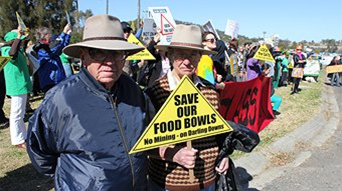 . .
‘Coal is killing Australia’, new book reveals’
[Source: ‘Coal is killing Australia’, new book reveals’, By Christa Schwoebel, 20120527, ^http://www.greenleft.org.au/node/51154]
.
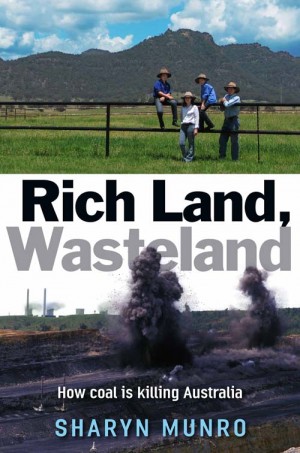
‘Rich Land, Wasteland’
book by Sharyn Munro
Exisle Publishing & Pan Macmillan
453 pages, pb, $29.99
^http://www.exislepublishing.com.au/Rich-Land-Wasteland.html
.
<<When a coalmine starts up near a township, a village or a farm it is to be expected that lives will change.
Indeed change is often promised and welcomed ― more Jobs, more money flowing into the community, better roads and services. In short, progress is promised.
The reality, however, is that not only do the benefits not evolve as the mines begin their operations, they destroy the land, pollute the water and air, erode people’s physical and emotional health and rip up the social fabric.
The media lead us to believe that Australia’s wellbeing depends on the mining sector. The more minerals that are exported, the healthier the Australian economy is and the better off we are. But such stories hide the real impacts of mining from most Australians.
Sharyn Munro puts aside “the diversionary cloud of spin” and tells the real story of coal mining. A resident of the upper Hunter who saw the coal mines taking over vast tracts of that valley, she spent a year travelling to the different parts of Australia where coalmining is destroying communities, livelihoods and ecosystems.
She found that “coal is killing Australia”.
Meeting victims of the industry in NSW, Queensland, Victoria, in WA and Tasmania, she records their stories. In Rich Land, Wasteland, she lets them tell their side of the story.
They tell us that there is “a war taking place in Australia”. It is an invasion where “the invaders are mostly foreign or multinational”. It looks like the second invasion of the continent.
The victims of this war, the people harassed and displaced by the mines, are fighting the invasion and mostly they have been fighting alone. They live in smaller communities or on the land, isolated from neighbours by distance and by the mines’ strategies of divide and take over.
All are deeply shocked by the lack of support from the governments and the legal system.
With their health, properties and livelihoods on the line, they try to stand up against the wealthy opponents.
The “warring sides are more unevenly matched than any David and Goliath cliche can convey”, the book says. Most of them have taken the fight up reluctantly. But if they are not despairing early on, they get increasingly incensed by the injustice they experience.
All are disillusioned, if not deeply depressed, by the failure of democratic processes.
Occasionally, they win a small concession ― only to be wiped out again by the mining companies’ blatant disregard of the conditions placed on their operations or by changed government regulations.
Where the invasion has been beaten off, as in the Margret River region in WA, the attackers regroup a short distance away, where they hope resistance will be weaker.
Each of the individual stories Munro presents is underpinned with meticulously researched facts and figures. Judiciously inserted at relevant points, these expand the anecdotal evidence into a systematic documentation of the true impact of coalmining.
In some sections, the seemingly obvious becomes a revelation.
.
Take the impact of dust:
.
From the blasting and machinery working in open cut mines, to vast piles of overburdened, uncovered coal trains up to two kilometres-long on their way to the ports and fly-ash from the coal power stations, it negatively affects the health of people, animals and plants.
The dust consists of smaller and larger particles of lead, arsenic and mercury, which are inhaled and ingested by animals and humans. Its role in higher rates of health problems such as asthma have been proven, yet the government does not act.
Contrary to the findings and advice of medical experts, governments assures residents they have nothing to fear. In 2010, the Independent Review of Cumulative Impacts on Camberwell (Hunter) “dismissed fears mines are making people sick”.
The report advised people to stay inside, close doors and wear masks, put on air-conditioners and seek medical advice.
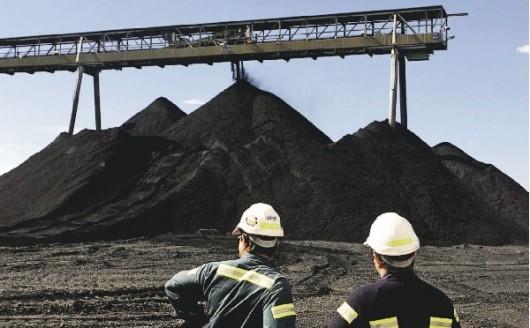 . .
Conditions placed on mining operations, such as to reduce dust, are hardly ever monitored ― except by the mining companies themselves. Their results never surprise.
There are many more, widely varied aspects to this war. These include issues such as ownership of mines and who benefits, the fast and huge expansions of coal mining as well as coal seam gas exploration and extraction, collusion of mine operators and government agencies, strategies applied to move people out of the way of mines, the impact of the predominantly male fly-in-fly-out workforce, higher road traffic, new exclusive rail lines and shipping in the Great Barrier Reef.
Everywhere there is environmental destruction, a lack of ― indeed the impossibility of ― site rehabilitation, and water depletion and water contamination. Everywhere, it poses the question: how can this happen in a democratic country such as Australia?
With so many details, an index would help reading and following up on some facts. The subheadings to the chapters that list locations help only to a point. I would have liked a list of acronyms and some maps.
However, when turning to the internet to look for the locations, I found that satellite maps gave extra insights into the vast onslaught of coal mines on the country.
Reading this book, veil after veil is lifted, revealing the reality of Australia today. It could be a deeply depressing book, if it weren’t for the encounters with many individuals who are standing up and speaking out.
As one says, “you must fight or nothing happens”. Munro encourages the readers to add their voices, stop the plunder and “speak up for the smart, sustainable and humane Australia we could be instead” ― the country worth fighting for.>>
.
 Government vested interest in Coal Mining
‘In 2008-09 the royalty revenue generated by the NSW minerals sector was $1.28 billion, with coal accounting for approximately 95% of the total.’
[Source: New South Wales Government, Division of Resources and Energy – Minerals and Petroleum,
^http://www.resources.nsw.gov.au/resources/royalty, website accessed 20121111] Government vested interest in Coal Mining
‘In 2008-09 the royalty revenue generated by the NSW minerals sector was $1.28 billion, with coal accounting for approximately 95% of the total.’
[Source: New South Wales Government, Division of Resources and Energy – Minerals and Petroleum,
^http://www.resources.nsw.gov.au/resources/royalty, website accessed 20121111]
.
‘Hunter coal mine fined for dust emissions‘
[Source: ‘Hunter coal mine fined for dust emissions’, by Cole Latimer, Safe To Work, 20120524, ^http://www.safetowork.com.au/news/hunter-coal-mine-fined-for-excessive-dust]
.
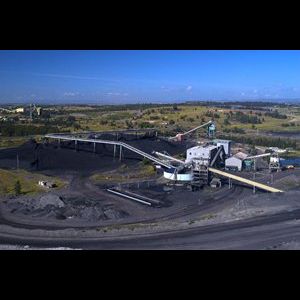
<<Rio Tinto’s Mt Thorley Warkworth coal mine has been fined by the NSW Department of Planning and Infrastructure after failing to minimise dust emissions.
A (paltry) $3000 fine was issued after an investigation into “significant dust emissions from the Mt Thorley Warkworth mine on Sunday 13 May,” the Department says.
The miner has been warned that “further breaches for dust emissions are likely to attract stronger enforcement action by the Department, including the potential for criminal proceedings in the Land and Environment Court”.
In January the mine came under fire for the placement of its water fill points, which reduced the effectiveness of the water cart fleet and its dust reduction activities.
Rio stated that this issue had been identified in 2010, and it had since secured funding to solve the problem, with the initial two fill points commissioned in December 2011, and the remaining three in February.
These new fill points are predicted to cut fill times by up to 15 minutes, while the storage capacity of each point has also been increased to enable continuous refills.
Rio stated that an early warning system for faults had been installed as well as automatic cut off.
It also received a number of noise complaints in January, accounting for 85% of submitted complaints.
According to the Department, breezes and low cloud cover contributed to noise transfer from the mines.
The Department’s executive director for major development assessment, Chris Wilson, said the mine has now failed to minimise offsite dust emissions and had not suspended or modified operations.
“Both the Upper Hunter Air Quality Network and the mine’s own real-time air quality monitor showed a spike in dust levels above the permitted 24 hour average,” Wilson said. “Our investigations have indicated that the mine’s air quality and dust mitigation measures required under the mine’s planning approval, were not adequate on that day.”
While the complaints occurred over a weekend, an officer from the nearby Singleton compliance unit was able to immediately attend the mine; Wilson adding that “the compliance officer observed that the mine was continuing to operate a dragline and excavator, despite dust being generated.
“These activities should have been suspended by the mine in the windy conditions.”
Under its existing operating approvals, the mine has to ‘implement best management practice to minimise odour, fume, and dust emissions’.
“This includes commitments by the mine to minimise wind-blown and traffic generated dust from coal handling and coal stockpiles, using water sprays on coal stockpiles to reduce airborne dust and using water trucks to minimise dust on roads. “The inspection found these commitments were not being complied with on 13 May,” Wilson said.
“Consequently large volumes of dust from mining operations flowed across the Putty road and the dust was also visible from the Golden Highway,” he added. “The decision to issue a penalty notice to the mine follows two previous warning letters last year in relation to dust.”>>
.
 . .
‘Foreign investors sow deep roots in food bowl’
[Source: ‘Foreign investors sow deep roots in food bowl’, by Leonie Lamont, Sydney Morning Herald (newspaper), 20110730, ^http://www.smh.com.au/nsw/foreign-investors-sow-deep-roots-in-food-bowl-20110729-1i4ar.html]
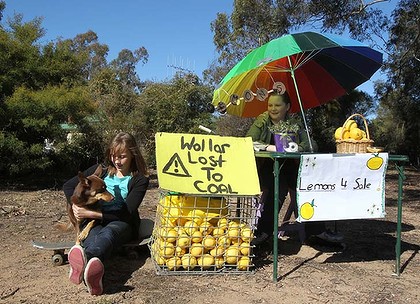 Sour taste … Ruby Marshall (age 12), and her sister April (age 11)
Display an anti-mining sign at their lemon stall in the former farming village of Wollar
(Photo by Peter Rae) Sour taste … Ruby Marshall (age 12), and her sister April (age 11)
Display an anti-mining sign at their lemon stall in the former farming village of Wollar
(Photo by Peter Rae)
.
<<Mining and energy companies have bought more than 35,000 hectares of rural land in NSW in the past year, in a scramble with foreign investors in agriculture to snap up prime sites.
A Herald review of land sales found the mining interest was focused on a swath of rural land extending from the Upper Hunter through the rich Liverpool Plains to Narrabri. Mining companies spent more than $85 million buying 27,500 hectares in this area – nearly 80 per cent of the total bought.
Community agitation about the collision of farming and mining interests has risen with miners’ purchases including $14 million paid by Coalworks for Kurrumbede, the family property of poet Dorothea Mackellar, near Gunnedah.
The miners’ outlay of $113 million is challenging overseas investment in agriculture, which amounted to $125 million in the past year, buying 225,000 hectares. Despite the soaring dollar, Australia’s openness to foreign investment has made it an attractive destination for miners as well as investors and sovereign wealth funds seeking to exploit the growing demand for agricultural produce.
Chris Meares, a land agent and rural property expert, said over the past year the main ”buying power” had been institutions, corporates and mining companies – many foreign-owned.
”In the last two years, credit has got very difficult to obtain in Australia,” he said. ”Initially [after the global financial crisis] the overseas investors said the dollar was too high, but then they saw some very good investment opportunities sitting there. Commodity prices were strong and there was little opposition from Australian investors, so they could come in and buy assets globally at very cheap rates. That’s what’s happened.”
The mining boom in NSW is underpinned by prices for thermal and coking coal, which have jumped almost 60 per cent over the past five years. Export prices for liquefied natural gas – which are driving the coal seam gas boom in Queensland and NSW – have risen 36 per cent in five years and are still rising.
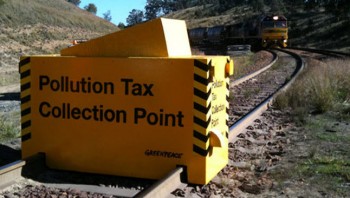
Mining companies said it was wrong to assume the sales meant the land was excised from agricultural use. Aston Resources said its 2800 hectares near Tamworth, which it bought for $4 million, would not be mined as it was an environmental offset – high value native trees and grassland next to the Mount Kaputar National Park, and cleared grazing land that would be leased to the original farming owner.
But Bruce Marshall, who moved to the former farming village of Wollar 20 years ago, said expansion by the mining giant Peabody Energy there had ”split the community”. Anti-mining signs adorn his fence and the fresh lemon stall run by his daughters April, 11, and Ruby, 12, beside the road to the mine site2.
This month, the NSW government set new environmental and consultative conditions for miners and extractors.
The NSW Minister for Resources and Energy, Chris Hartcher, said there had been a ”changed paradigm” that people had to acknowledge but residents and mining companies needed to know what the rules were.
”If it is essential to protect water or Prime Agricultural Land. We will not shy away from making the decision it is inappropriate [to mine] in these areas.”
The Herald used RP Data, a property information system, to review sales of more than 250 hectares during the past year. The review did not cover purchases by individuals – typically farming families – and small companies associated with them.
The biggest mining spender was Shenhua Watermark, majority owned by the Chinese government, which spent $26.5 million on 2700 hectares in the Gunnedah area. It has spent more than $200 million acquiring land for its planned $1.7 billion open-cut coal mining operation.>>
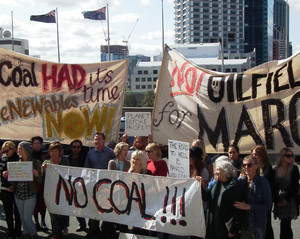 . .
‘Cancer concern for people surrounded by coal mines’
[Source: ‘Cancer concern for people surrounded by coal mines’, by Richard Noone, The Daily Telegraph, 20121030, ^http://www.news.com.au/national/cancer-concern-for-people-surrounded-by-coal-mines/story-fndo4bst-1226505615788]
.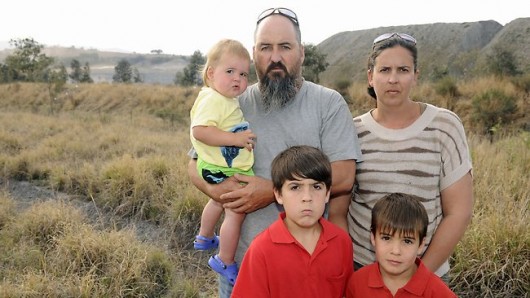 Jason and Belinda Passlow with children Harrison, Lachlan and William in Bulga (Hunter Valley)
(Photo by Waide Maguire, The Daily Telegraph) Jason and Belinda Passlow with children Harrison, Lachlan and William in Bulga (Hunter Valley)
(Photo by Waide Maguire, The Daily Telegraph)
.
<<People surrounded by coal mines in the Hunter Valley could be at more risk of cancer, heart, lung and kidney disease and birth defects.
A new report has found serious illnesses were rife in communities near mines overseas. The report calls for an urgent health impact study in the Hunter after analysis of 50 peer-reviewed research papers from 10 countries, including the US, the UK and China, found a wide range of adverse health effects in those living close to mines.
Lead author, Sydney University associate professor Ruth Colagiuri, said similar studies in Australia’s largest coal mining region were needed “so governments and community can make informed decisions and develop policies to minimise health harms”.
The study – Health and Social Harms of Mining in Local Communities: Spotlight on the Hunter Region – was commissioned by Beyond Zero Emissions. “With plans for 30 new or bigger coal mines, an independent authority is urgently needed to monitor emissions in the region and for an in-depth health study to take place,” BZE spokesman Mark Ogge said.
Mother-of-four Belinda Passlow said her two eldest children, Eleanor, 14, and Lachlan, 10, developed asthma after moving to Bulga, a village near four open cut mines in the Upper Hunter. She said they were forced “like most people around here” to put up with constant dust.>>
.
‘Stand with Coalfield Residents at Appalachia Rising (USA)’
[Source: ‘Stand with Coalfield Residents at Appalachia Rising’, by ‘Carolyna’, Greenpeace (USA), 20100917, ^http://members.greenpeace.org/blog/carolyna/]
.
Appalachia Rising is three days of coalfield residents and activists from across the country standing together for an end to Mountain Top Removal (MTR), an extremely destructive form of mining where the tops of mountains are blown off to extract the coal seams below.
I saw firsthand the effects of MTR on Appalachian communities while visiting Rock Creek, West Virginia (USA) this past January. Below is a selection of photos that my friend, Phoebe Neel, and I shot while bearing witness to the destruction.
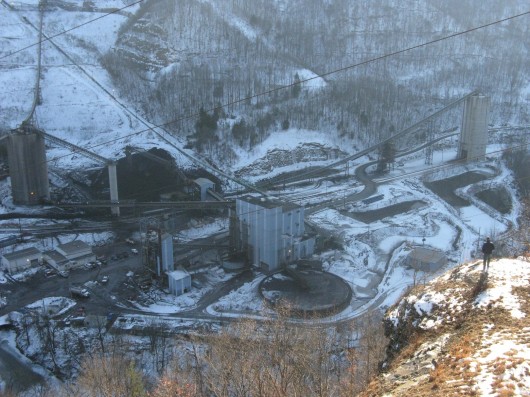 Goals Coal Plant in WV, owned by Massey Energy Goals Coal Plant in WV, owned by Massey Energy
.
This behemoth of a complex owned by Massey Energy contains the Goals Coal Processing Plant.
Above it, sits the Shumate Coal Sludge Impoundment Pond, which contains 2.8 billion gallons of toxic coal waste. Beyond that is the Edwight Mountain Top Removal site, whose blasting puts the dam at risk of failing.
Also out of the picture is Marsh Fork Elementary, which would be wiped out if such a failure were to occur. Thankfully, the community won a six year fight this past April to build a new school, which will break ground next year.
Just realized that most of my description was for what is NOT shown in this photo. It says something when you need to be that high up to see the extent of the problem.
.
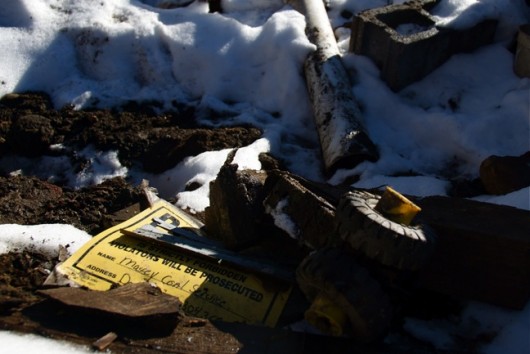 Massey Energy Notice
(Photo by Phoebe Neel) Massey Energy Notice
(Photo by Phoebe Neel)
.
A ‘No Trespassing’ notice from Massey Energy in the rubble of a demolished house. Massey bought out the residents of Lindytown, West Virginia (USA) one by one so the company could level the town and expand the mountaintop removal site that borders it. Saying the residents had a choice in the matter is a farce – with the noise, dust, and polluted well water that comes with MTR, you trade your health for your home.
.
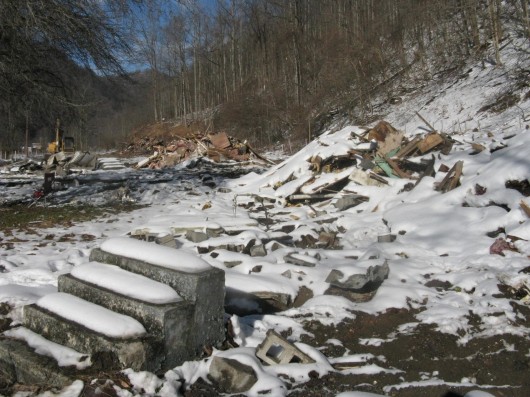 Demolished home in Twilight, West Virginia Demolished home in Twilight, West Virginia
.
This is a wider shot of Lindytown, which shows three homes that have been bulldozed. Surveying the scene, I remember thinking that it could’ve been the site of a natural disaster – a storm that had decimated the neighborhood. However, this was caused by man and was just a precursor to the much wider destruction of themining to come. Nothing would be rebuilt; those concrete steps would always lead to nowhere.
The next two photos should be looked at as a pair.
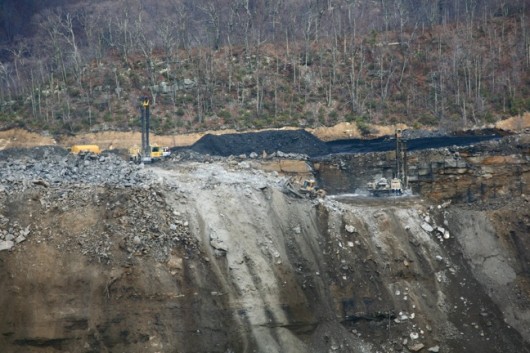 Bee Tree site
(Photo by Phoebe Neel) Bee Tree site
(Photo by Phoebe Neel)
.
This one is of the Bee Tree site in Pettus, West Virginia (USA) and the huge earth-moving machines that are used to extract the exposed coal. The striking thing about this for me is that all the rubble is refered to as “fill,” which companies like Massey dump into neighboring valleys, burying streams and polluting drinking water.
.
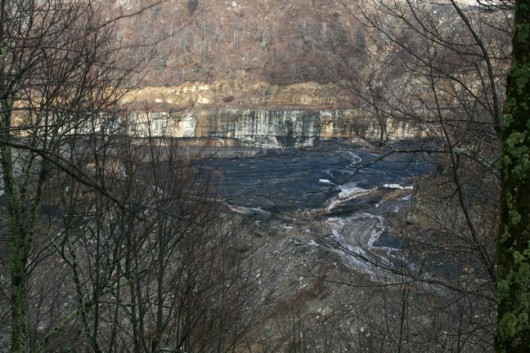 Brushy Fork Impoundment
(Photo by Phoebe Neel) Brushy Fork Impoundment
(Photo by Phoebe Neel)
.
This last photo is of the Brushy Fork Impoundment, which at 8.2 billion gallons, holds much more coal waste than the Shumate Impoundment. However, it has one important thing in common – it’s also located close to an MTR site, where blasting can affect its structural integrity. It lies less than half a mile away from the Bee Tree site. Marfork Coal, a subsidary of Massey Energy, estimates a dam failure could cause a wave of coal sludge as high at 72 ft.
This is just a small selection of what I witnessed in West Virginia. And when you come to DC for Appalachia Rising, you won’t see any of these scarred landscapes. But what you will see are more people like Maria Gunnoe – people who refuse to give up and instead are rising up.
.
Coal Bin Flag
. 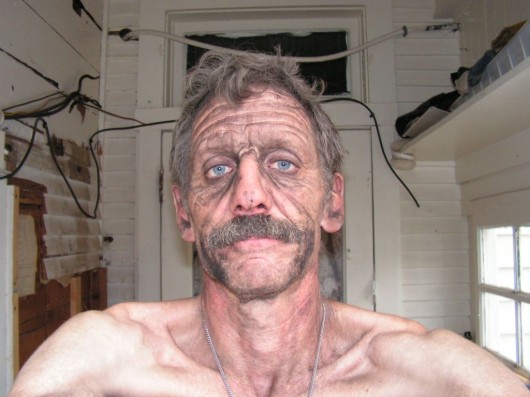 Coal Dust Victim Coal Dust Victim
.
<<The dirtiest part of resurrecting this old house was cleaning the Coal Bin.
If you’ve never been in a Coal Bin, you may not have a sense of how coal dust can get everywhere. I mean ev-er-y-where. Coal dust is insidious. It gets everywhere on your body – even in places you didn’t know you had places. And it instantly goes airborne when disturbed from its decades-long slumber.
A normal shop vacuum filter has no use in this environment. Coals dust passes right through the filter. The only way to capture the dust is with one of the expensive filters.
Our coal bin took two days to clean and dismantle.
The best part about the job was finishing. The second best part was this old flag.
This 48 star flag is easy to date. Arizona, our 48th state was added in 1912, roughly four years after Harry & Carrie Benham built this great old house. It was replaced by our current 50 star flag in 1960 when Alaska and Hawaii were added to the Union. So in 2007 when I found this flag in the coal bin it was between 47 and 95 years old.
I can’t narrow it down any more than that, but I like to imagine the flag was placed there about the time the old coal burner furnace was converted to gas – maybe in the 1950s.>>
[Source: ^http://residencehill.blogspot.com.au/2012/03/coal-bin-flag.html]
.
 ‘Devil’s Dust’ – past decades of asbestos fibre exposure are being repeated with coal dust exposure
..it’s just that the law hasn’t caught up yet. ‘Devil’s Dust’ – past decades of asbestos fibre exposure are being repeated with coal dust exposure
..it’s just that the law hasn’t caught up yet.
.
Tags: Appalachia Rising, Appalachian Mountains, Black Lung, Cancer Council Australia, Chris Hartcher, Coal Dust, Coal Mining, Coal Workers Pneumoconiosis, Coalfield Residents, coalmines, devil's dust, Edwight Mountain Top Removal, food bowl, Goals Coal Processing Plant, Greenpeace, Hunter Valley, lung disease, Massey Energy, Miner's Asthma, mining royalties, Ohio Valley Environmental Coalition, Prime Agricultural Land, Shenhua Watermark, Shumate Coal Sludge Impoundment Pond, Silicosis, Singleton Shire Healthy Environment Group, Wollar
Posted in Threats from Mining | No Comments »
Add this post to Del.icio.us - Digg
Sunday, September 9th, 2012
Does wilderness still matter? Or is it just a nostalgic and overblown idea from the 1960s that has worn out its usefulness?
Unsurprisingly, the Colong Foundation for Wilderness vigorously asserts that wilderness is more important than ever. As the global environment plummets into crisis, ‘business as usual’ is rushing ever more recklessly in the opposite direction, chasing the almighty dollar. Our parks, reserves and natural areas are everywhere imperilled, by climate change, mining, tourism and many other threats. Wilderness remains a sanctuary and an insurance against the complete exploitation of nature.
Which is why the Colong Foundation has taken up the baton again for the Sixth National Wilderness Conference, established by Geoff Mosley and the Australian Conservation Foundation in 1977. The 5th and most recent conference, Celebrating Wilderness, was hosted by the Colong Foundation in 2006.
.
6th National Wilderness Conference
.
The 6th National Wilderness Conference will be held in Sydney on 21-23 September 2012 and co-presented by the NSW National Parks Association and the Nature Conservation Council of NSW.
With environmental protection laws under attack in all states and nationally, this conference comes at a critical time. So if you haven’t signed up for this conference yet, now’s the time. And don’t forget the Conference dinner, $40 for three beautiful courses at Maynard’s Café, Newtown.
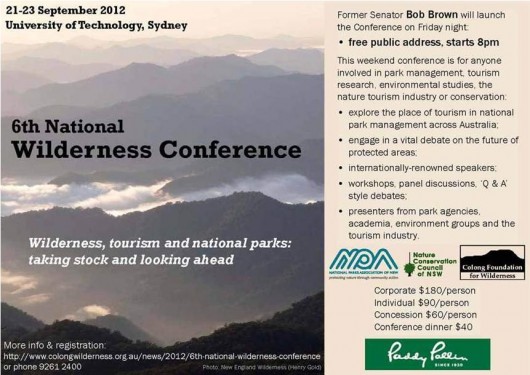
^Online Conference registration
^Program brochure and more information
Wednesday, July 18th, 2012
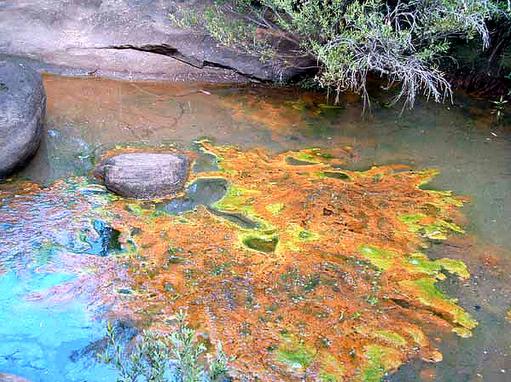 Toxic Omelette killing all life in the Georges River Toxic Omelette killing all life in the Georges River
The EPA in New South Wales (NSW) is accused of ignoring BHP’s coalmine’s toxic contamination of Georges River for over a decade
[Source: ‘Coalmine discharge fouls Australia’s Georges River’, by ‘Jim’, 20100803, Desdemona Despair .net, ^http://www.desdemonadespair.net/2010/08/coalmine-discharge-fouls-australias.html]
.
Ed: The Political Climate Change Fad has negated funding of the Environment Protection Authority from critical Pollution Control.
.
 The Upper Georges River
Near the Dharawal National Park, NSW
[Source: ‘Coalmine discharge fouls Georges River’, ^http://off.oatleypark.com/?p=904] The Upper Georges River
Near the Dharawal National Park, NSW
[Source: ‘Coalmine discharge fouls Georges River’, ^http://off.oatleypark.com/?p=904]
What is the Environmental Protection Authority (EPA) in New South Wales (NSW) doing?
It took an arbitrary bushwalk by a few bushwalkers of the local Macarthur Bushwalkers Club to by chance discover pollution of a remote section of the Georges River down from a coal mine in the Illawarra Region of NSW.
Although they dutifully reported the pollution incident to the NSW EPA, nothing was done, and that was over ten years ago, yet the mine has continued polluting the Georges River.
Labor and Liberal successive NSW Governments have known for more than a decade about this major toxic plume in the Georges River from a coalmine owned by BHP Billiton discharing into the upstream tributary Brennans Creek, but have never pressed the company to stop polluting. Why?
Metals such as zinc, copper, nickel and aluminium, as well as elevated levels of arsenic, are much higher than healthy guidelines, and the contamination has seriously damaged the ecosystem of the river for 15 kilometres downstream from the mine, documents obtained by the Herald show. Environment groups have begun a civil court case against BHP Billiton, which operates the West Cliff coalmine near Campbelltown via a subsidiary company.
.
Ed: This is Australia in 2012, not 1912!
.
The O’Farrell Government‘s Environment Minister, Robyn Parker, said yesterday:
”The EPA needs to lift their game,” Parker said. ”We’ve put them there, and given them increased powers and increased responsibility, and I need to see some action from them.”
Yet on the same day, Parker has hypocritically announced savage staff cuts to the Environment Department. Internal documents circulated among employees said the Department had committed to cutting costs in kangaroo harvesting programs [Ed: poaching wildlife?] , reducing wilderness and wild river assessments, deregulating wildlife licensing where appropriate, scaling back soil and salinity research and ”reducing effort in our biodiversity programs” i.e. ‘frontline services’.
.
Ed: The O’Farrell Government’s Environment Minister, Robyn Parker, has just announced axeing 350 jobs in Environment and Heritage including in the EPA as well as culling many programmes in national parks and animal management, all to save $101 million by 2016. Notably in the O’Farrell Budget 2012-13, the sum of $150,000,000 has been “appropriated to the Treasurer for the recurrent services of the Advance to the Treasurer.” [Clause 18, p16, Budget Paper Appropriation Bill 2012, >Read Bill]
.
Jul 2012: Miner BHP Billiton sued for river pollution by its West Cliff Colliery near Appin
[Source: ‘Regulator ignores toxic plume polluting river for a decade’, 20120718, by Ben Cubby, Environment Editor, Sydney Morning Herald, ^http://www.smh.com.au/environment/conservation/regulator-ignores-toxic-plume-polluting-river-for-a-decade-20120717-228jw.html]
.
Listed Australian Mining Conglomerate, BHP Billiton at its BHP Billiton’s Illawarra Coal subsidiary ‘Endeavour Coal‘, received a court summons yesterday, but did not respond directly to questions. Instead, it publicised a brief PR legal statement stating: ”The company complies with environmental regulations and is reviewing the details of this matter.”
A string of correspondence between the company and the EPA goes back as far as 2002, and shows that the regulator had been aware of discharges from the mine and some of its environmental impacts for most of that time.
The discharges from the mine flow into Brennans Creek, a tributary of the Georges River, and contain pollution from coal washing, water that has been pumped out of the mine tunnels, and stormwater runoff.
But the matter became public only because bushwalkers noticed the pollution and arranged for independent tests by Ian Wright, an environmental scientist at the University of Western Sydney.
About two years ago Dr Wright took a group of students and some rudimentary laboratory equipment to the river and has since returned many times to check and recheck the results.
”I thought ‘it can’t be as bad as it looks’. But I was wrong about that. You could just see the change in the water,” Dr Wright said. ”It was grey coloured. There was a lot of turbidity and coal ash.”
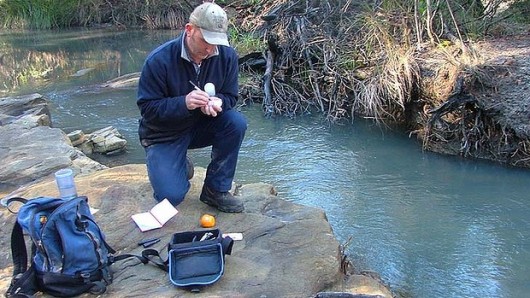 ”I thought ‘it can’t be as bad as it looks”
… UWS Environmental Scientist, Dr Ian Wright. ”I thought ‘it can’t be as bad as it looks”
… UWS Environmental Scientist, Dr Ian Wright.
.
The scientific results showed startling differences from some of the pristine waterways nearby, on the edge of the Dharawal National Park. The aquatic invertebrates – mainly small insects – that form the basis of the food chain were either very scarce or missing altogether.
”It’s knocking around the food chain and the biology in the Georges River,” Dr Wright said.
”Upstream, we’ve got the full complement of invertebrates that you would expect to find. Downstream, there are groups missing and others at very low abundance. The invertebrate data is consistent with a very polluted or degraded waterway.”
The court case is brought by the National Parks Association of NSW and the Macarthur Bushwalkers Club.
Ed: Natural Justice defended not by the EPA, but by the Macarthur Bushwalkers Club (commercial income zero) versus BHP Billiton (commercial income US$37.5 Billion)
.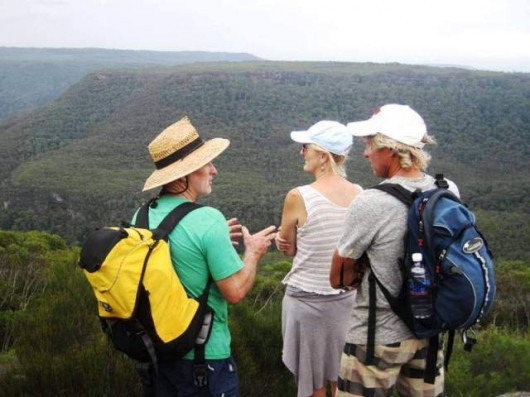 Bushwalkers
Bushwalkers
.
2010: ‘Coalmine discharge fouls Georges River‘
[Source: ‘Coalmine discharge fouls Georges River’, 20100804, by Ben Cubby, Environmental Reporter, Sydney Morning Herald, ^http://www.smh.com.au/environment/coalmine-discharge-fouls-georges-river-20100803-115gr.html; ‘Coalmine discharge fouls Australia’s Georges River’, by ‘Jim’, 20100803, ^http://www.desdemonadespair.net/2010/08/coalmine-discharge-fouls-australias.html]
.
‘Contaminated water from a coalmine [BHP Billiton’s Endeavour Coal] is flowing into the Georges River, south of Sydney, at levels that are toxic to aquatic life, an independent water quality report has shown.
A plume of saline water stretched along the river for 15 kilometres from the discharge point of an underground mine operated by Endeavour Coal, a subsidiary of BHP Billiton’s Illawarra Coal.
Discharges from Endeavour Coal’s West Cliff Colliery near Appin are ”causing serious water pollution that is very likely to be damaging in-stream ecosystems,” says the report, which was completed on a voluntary basis by researchers from the University of Western Sydney.
But the environmental protection licence for the mine’s wastewater discharge does not limit the amount of saline water that can be flushed into the river.
”I can’t believe that we have put out something called an environment protection licence without any provision to protect the environment,” one of the authors, Dr Ian Wright, a freshwater ecologist at UWS, said. ”Salt at these levels is huge in the context of a river … If you sprayed it on your tomatoes they would wilt.”
The NSW Department of Environment, Climate Change and Water said it was evaluating salt discharge levels that had already been measured by BHP Billiton at the site.
”There is currently no limit for salinity,” a spokesman for the department said. ”However, salinity discharges to Brennans Creek are currently regulated by a staged pollution reduction program under the current environment protection licence.”
When tested last month, the water discharged from the mine was five times more saline than the safe level recommended by the Australian and New Zealand Environment Conservation Council, a standard used by governments to determine water quality for aquatic life. It was nearly 10 times more saline than water in surrounding creeks.
The researchers tested upstream and downstream from the discharge pipe and also the water flowing directly from it.
They concluded that the environmental protection licence ”provides little effective protection to the Georges River” and said it was likely to damage the river’s ecosystems, meaning small invertebrates, fish and related denizens of the local food chain.
The colliery forms part of the company’s proposal to extend a series of coalmines around the township of Appin, so as to be able to extract $2 billion worth of coal a year for 30 years..
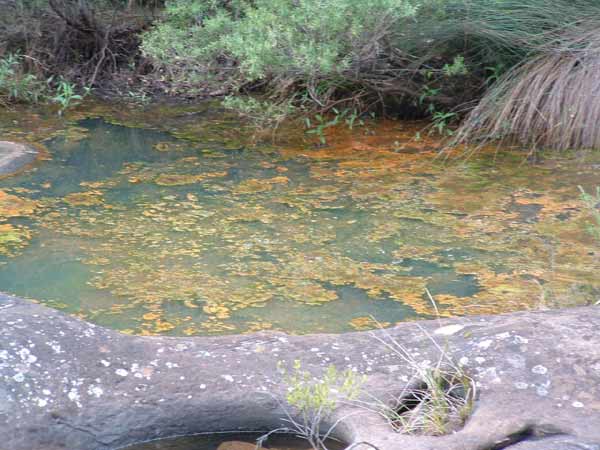 Contamination from coal mining near the Cataract River in Australia, November 2007
[Source: ^http://www.georges-river-macarthur.com/graphics/pollution/05_08.jpg] Contamination from coal mining near the Cataract River in Australia, November 2007
[Source: ^http://www.georges-river-macarthur.com/graphics/pollution/05_08.jpg]
.
Jan 2011: Meanwhile Barry O’Farrell pledges to Protect Wilderness
[Source: Barry O’Farrell pledges to Protect Wilderness, by Ben Cubby and Sean Nicholls’, 20110108, ^http://www.illawarramercury.com.au/news/local/news/general/barry-ofarrell-pledges-to-protect-wilderness/2041885.aspx?storypage=0]
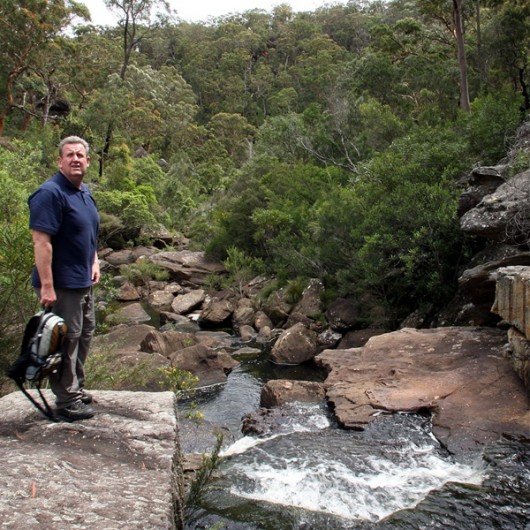 Premier Barry O’Farrell
Next to a watercourse in Dharawal National Park, that flows into the Georges River
Premier Barry O’Farrell
Next to a watercourse in Dharawal National Park, that flows into the Georges River
Jun 2012: O’Farrell now in government: “No deal has been done” with the mining company”
[Source: ‘Sydney snares park conservation event’, by Heath Aston, Merredin Mercury, 20120617, ^http://www.merredinmercury.com.au/news/national/national/general/sydney-snares-park-conservation-event/2592836.aspx]
.
‘Thousands of hectares of pristine wilderness near Appin, fought over by mining and environment interests for decades, will be saved and opened to the public as a national park if the NSW Coalition wins government in March.
But the announcement, to be made today by Opposition Leader Barry O’Farrell, sets up a potential conflict with BHP Billiton, which still holds the right to mine the billions of dollars worth of coal in the area.
The park, based on the Dharawal State Conservation Area, would add about 6200ha of bushland to the public estate, and provide one of the final pieces to the jigsaw of protected wilderness areas around Sydney.
It is one of the last remaining areas of intact natural bushland near the city, and sits between the Royal National Park and the Blue Mountains World Heritage Area.
Mr O’Farrell said “no deal has been done” with the mining company, which revised plans to mine under the conservation area in October but retains the right to apply again over the 30-year life of its lease.
Mr O’Farrell, who hiked in the area yesterday with environment groups, acknowledged the Coalition would need to enter into discussions about potential compensation.
“We will be having sensible discussion with the relevant stakeholder to get the best outcome for the community,” he said.
“It’s an area that has significant Aboriginal history, it has significant environmental history. It’s accessible, which means … people could go and visit and have access to our great natural environment.”
A peak environment body, the Nature Conservation Council of NSW, and the National Parks Association welcomed the plan.
“We see the Dharawal National Park proposal as an important step towards better conservation in Sydney’s drinking water catchment and beyond,” the council’s director Pepe Clarke said.
Head of the Total Environment Centre Jeff Angel said: “We look forward to more enlightened environment policies from the Coalition and note the new park should be gazetted without a depth restriction in order to protect it from mining.”
A BHP Billiton subsidiary, Illawarra Coal, had planned to dig up $60 billion worth of coal over the next 30 years, much of it from under Dharawal.
The area became the centre of a bitter campaign over reconciling coal mining and clean drinking water catchments. It contains 632 Aboriginal sites, as well as 226 upland swamps filtering water into the Georges River through 46 streams. More than 200 native animal and plant species are found there, including the vulnerable powerful owl, yellow-bellied glider and eastern pygmy possum.
The mining plan was revised in October, after the NSW Planning Assessment Commission released a scathing report into the proposed mine, which was expected to crack the surface of the conservation area and drain some of its water-filtering swamps.
In a landmark review, the commission cited the threat to water catchments and concluded that society would be better off if the coal was left in the ground.
A new plan excluding coal mining under Dharawal and other vulnerable areas is being considered by the Government.
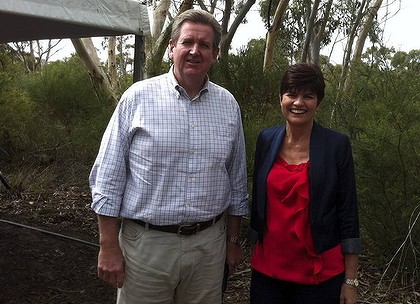 Premier Barry O’Farrell and his Environment Minister Robyn Parker opening Dharawal National Park. Premier Barry O’Farrell and his Environment Minister Robyn Parker opening Dharawal National Park.
.

Further Reading:
[1] Georges River Macarthur Region, ^ http://www.georges-river-macarthur.com/gr_cataract_river.html
.
[2] ‘Dharawal new national park is born’, by Murray Trembath, 20120327, ^ http://www.theleader.com.au/news/local/news/environment/dharawal-new-national-park-is-born/2501284.aspx
.
[3] Georges River, ^ http://www.georgesriver.org.au/
.
[4] ‘Parks will go unstaffed as environment jobs slashed’, 20120718, by Ben Cubby and Josephine Tovey, Sydney Morning Herald, ^ http://www.smh.com.au/environment/conservation/parks-will-go-unstaffed-as-environment-jobs-slashed-20120717-228cn.html]
.
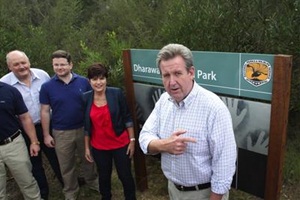
.
Tags: Aluminium, Arsenic contamination, BHP Billiton, Brennans Creek, Coal Mining, Copper, Endeavour Coal, Environmental Protection Authority, EPA, Georges River, Macarthur Bushwalkers Club, National Parks Association of NSW, Nickel, O'Farrell Government, River Pollution, Robyn Parker MP, Toxic Omelette, West Cliff Colliery, Zinc
Posted in Threats from Mining, Threats from Pollution | 1 Comment »
Add this post to Del.icio.us - Digg
|
|
 Arthur River Rainforest in Tasmania’s Tarkine
[Source: Photo by Ted Mead, ^http://tarkine.org/)
Arthur River Rainforest in Tasmania’s Tarkine
[Source: Photo by Ted Mead, ^http://tarkine.org/)
 Savage River Mine tailings spill into Tasmania’s wild Pieman River
[Source: ‘‘I have never seen anything like it’, 20130325, by Isla MacGregor, Tasmanian Public and Environmental Health Network,
in Tasmanian Times, ^http://tasmaniantimes.com/index.php?/weblog/article/i-have-never-seen-anything-like-it/]
Savage River Mine tailings spill into Tasmania’s wild Pieman River
[Source: ‘‘I have never seen anything like it’, 20130325, by Isla MacGregor, Tasmanian Public and Environmental Health Network,
in Tasmanian Times, ^http://tasmaniantimes.com/index.php?/weblog/article/i-have-never-seen-anything-like-it/]
 Grange Resources, Savage River Mine
Recklessly destroying and polluting The Tarkine
thanks to disinterested approval by selfish old men Babyboomer politicians in Hobart
Grange Resources, Savage River Mine
Recklessly destroying and polluting The Tarkine
thanks to disinterested approval by selfish old men Babyboomer politicians in Hobart
 .
. Circular Head Mayor Daryl Quilliam
(a Babyboomer…)
Circular Head Mayor Daryl Quilliam
(a Babyboomer…)
 Federal Environment Minister Tony Burke
Federal Environment Minister Tony Burke
 Mr Scott Jordan
Tarkine National Coalition
(Photo by Eliza Wood).
Mr Scott Jordan
Tarkine National Coalition
(Photo by Eliza Wood).




























































































